ANCIENT MESOPOTAMIA SPEAKS
Highlights from the Yale Babylonian Collection
This is the accessible version of the tour designed specifically for users needing extra accessibility features.
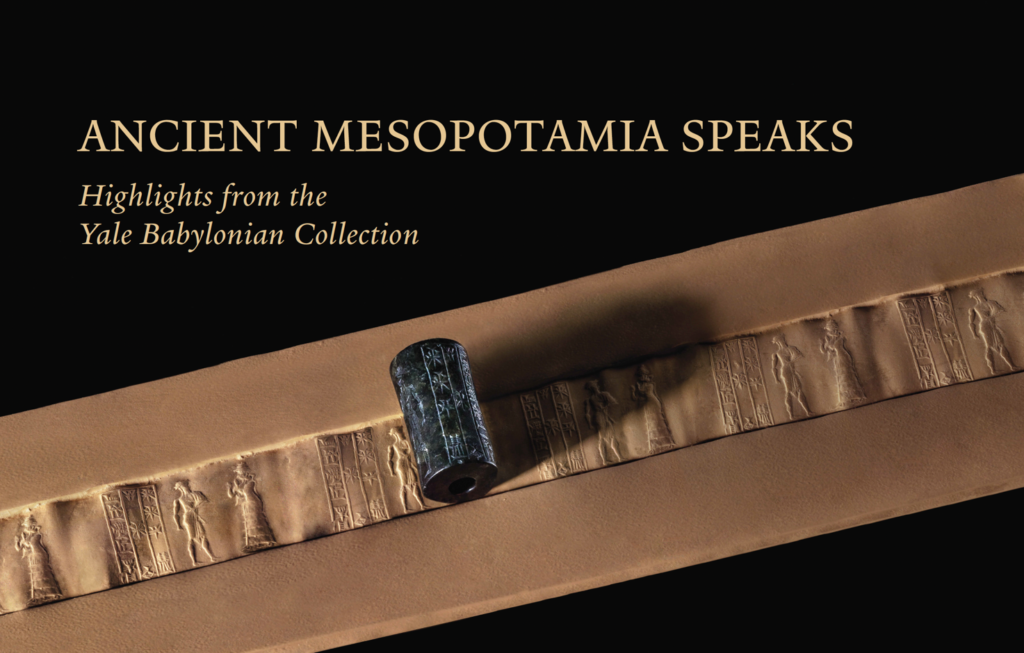
Ancient Mesopotamia Speaks. Intro banner
INTRO
SECTION 1: WRITING
SECTION 2: HEROES, GODS AND DEMONS
SECTION 3: DAILY LIFE
SECTION 4: KINGS, CRIMINALS, AND CONSPIRATORS
SECTION 5: SCIENCE AND SCHOLARSHIP
SECTION 6: YALE BABYLONIAN COLLECTION
INTRODUCTION
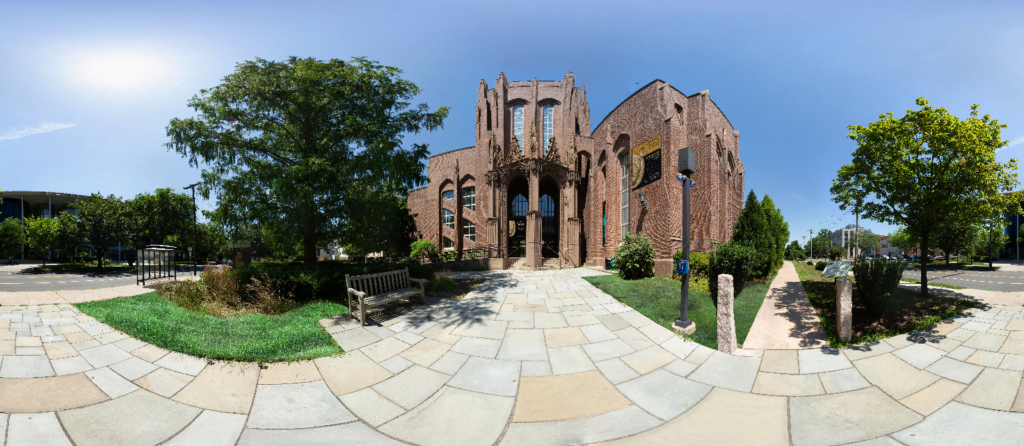
Exterior of the museum
Ancient Mesopotamia, the “Land between the Rivers,” was the birthplace of writing, urban culture, the state, and many other concepts and institutions that shape our world to this day. Stretching from the Tigris to the Euphrates in what is now Iraq and Syria, Mesopotamia has produced beautiful and intriguing works of art, myths and epics celebrating gods and heroes, treatises on mathematics and medicine, but also thousands of letters by ordinary people, and even the world’s first cookbooks.
BANNER: Map and timeline
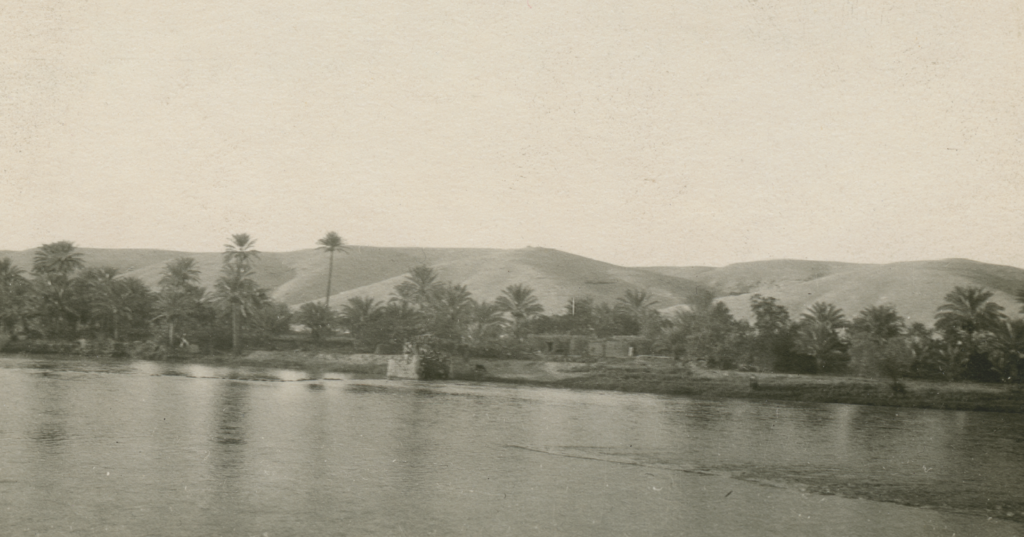
The Euphrates near Anah, 1920, Yale Babylonian Collection Archives
On view here are some one hundred and fifty artifacts, from clay tablets inscribed in cuneiform to intricately carved seals to monumental basreliefs. Almost all are from the Yale Babylonian Collection, founded in 1911 and today one of the major repositories of Mesopotamian artifacts outside Iraq. At a time when Mesopotamian cultural heritage is gravely endangered, the objects on display here seek to give voice to this ancient civilization and allow Mesopotamia to “speak” again, through its texts and imagery.
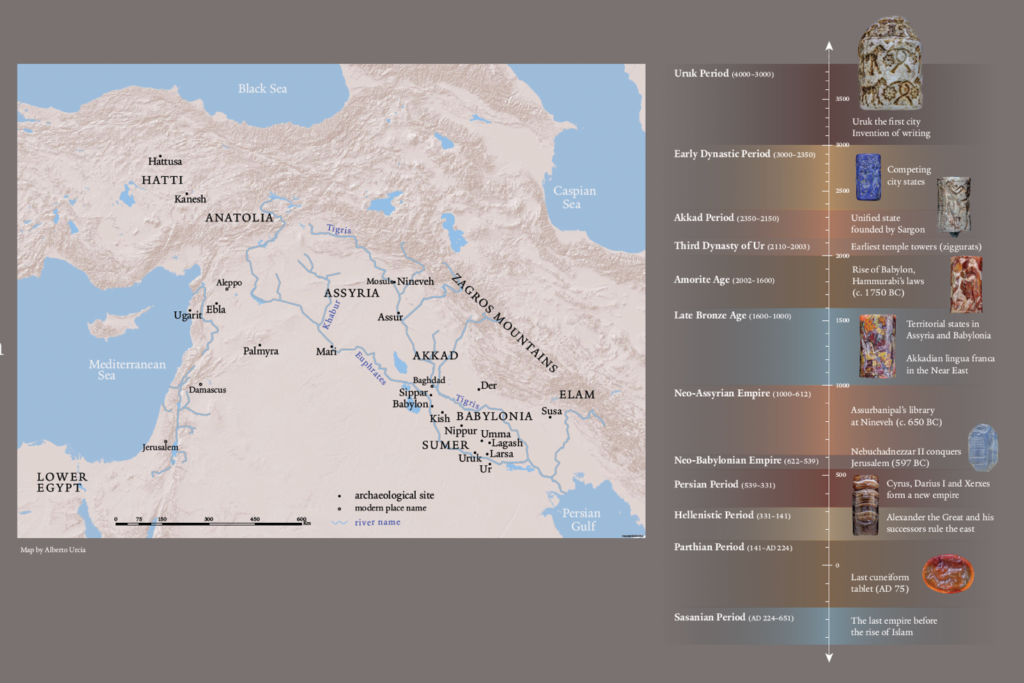
Map of the Mesopotamia (by Alberto Urcia)
BANNER: Archaeology and Cultural Heritage

Image on left: Scientific excavation in progress at Ur in southern Iraq in 2015.
Image on right: The site of Umma in southern Iraq, pockmarked with hundreds of looters’ pits in 2012.
Archaeological sites and their artifacts, especially in the Middle East, are a nonrenewable cultural heritage in constant danger. Along with development, erosion, and neglect, many Middle Eastern sites have suffered from looting, military activity, and deliberate destruction.
Ancient Mesopotamia Speaks bears witness to what has been lost and seeks to counter attempts by radical forces to silence a sometimes inconvenient past. And yet, admittedly, most objects here are not from scientific excavations. During the Yale Babylonian Collection’s first decades artifacts were commonly bought, with little interest in documenting where they were found. Although this has deprived us of important data, we can still reconstruct the cultural settings of many objects.
BANNER: Credits
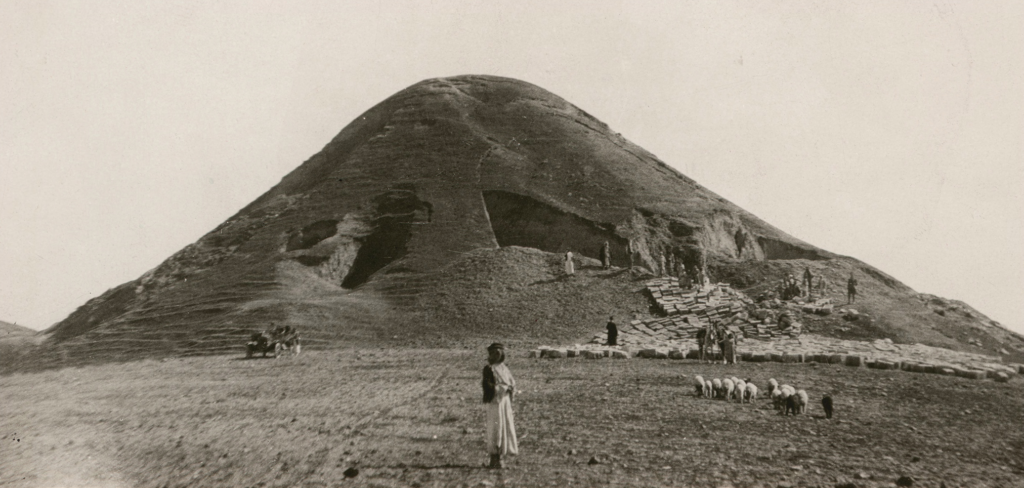
The temple tower at Nimrud. 1920. Yale Babylonian Collection Achieve
SPONSORS
The Yale Peabody Museum of Natural History gratefully acknowledges the following for their contributions and support of this exhibition.
Edward P. Bass ’67
Connecticut Humanities
Victoria K. DePalma
The Viscusi Fund of the Department of Near Eastern Languages & Civilizations, Yale University
Hawkinson Conservation and Exhibition Fund
The Institute for the Preservation of Cultural Heritage
Curated by Agnete W. Lassen, Eckart Frahm and Klaus Wagensonner
SECTION 1: WRITING

Writing emerged in southern Mesopotamia in the second half of the fourth millennium BC. At first pictographic, with symbols resembling physical objects, signs would soon become more abstract and develop into the writing system known as cuneiform (“wedge-shaped”), because of its characteristic clusters of triangular impressions left by a reed stylus on damp clay. Cuneiform has roughly one thousand signs that represent both words and syllables. Mostly used to write Sumerian and Akkadian, it was later adapted for other languages.
Cuneiform initially served to record economic texts and word lists. Over time, it was also used to write letters, contracts, royal inscriptions, literary and religious texts, medical treatises, rituals and
incantations, dictionaries, and much more. Lost and forgotten since the first centuries AD, these texts speak to us again today thanks to the dedicated scholars who deciphered cuneiform in the nineteenth century.
Panel: Early Information Technology
Stamp and cylinder seals were an early form of information technology that from the seventh millennium bc onward marked ownership or association. In the fourth millennium bc, they were impressed on bullae, hollow clay balls that accompanied goods and contained small clay tokens symbolizing commodities and their quantities. The first writing borrowed symbols from these tokens, but integrated them into a much more advanced system. Over time, sign shapes changed considerably.

Object 1: Stamp Seal in the Form of a Lion Head
Limestone
Uruk period (c. 4000–3000 bc)
Possibly from Susa
YPM BC 036918
NCBS 21
Object 2: Cylinder Seal with Priest-king Feeding a Herd
Marble
Above is a digitally rolled out image of this seal
Late Uruk period (c. 3500–3000 bc)
YPM BC 005552
NBC 2579
Object 3: Piedmont Style Cylinder Seal
Lapis lazuli
With rolled out impression on polymer
Late Uruk period (c. 3500–3000 bc)
YPM BC 038015
NBC 12151
Object 4: Cylinder Seal with Vessels
Rock crystal
With rolled out impression on polymer
Late Uruk period (c. 3500–3000 bc)
YPM BC 038016
NBC 12141
Object 5: Cylinder Seal Showing Women Engaged in Pottery-making
Red marble
With rolled out impression on polymer
Late Uruk period (c. 3500–3000 bc)
YPM BC 036926
NCBS 29
Object 6: Cylinder Seal Fragment Showing a Bull Carrying an Image of Inana
Marble
With rolled out impression on polymer
Late Uruk period (c. 3500–3000 bc)
YPM BC 036919
NCBS 22
Object 7: An Early Account of Slaves
Clay
Uruk III period (c. 3300-3000 bc)
Possibly from Larsa
YPM BC 008902
NBC 5921
Object 8: An Early Account of Small Cattle
Clay
Uruk III period (c. 3300-3000 bc)
Southern Babylonia
YPM BC 021120
YBC 7056
Object 9: A Late Account of Small Cattle
Clay
Persian period, January 13, 526 bc
Uruk
YPM BC 018036
YBC 3971
Panel: Materials and shapes
Clay was the main writing medium, but cuneiform was also written on stone and metal. It was used on objects of all shapes and sizes, from minute to monumental, from rectangular to round, and on prisms, cylinders, cones, and triangular tags.
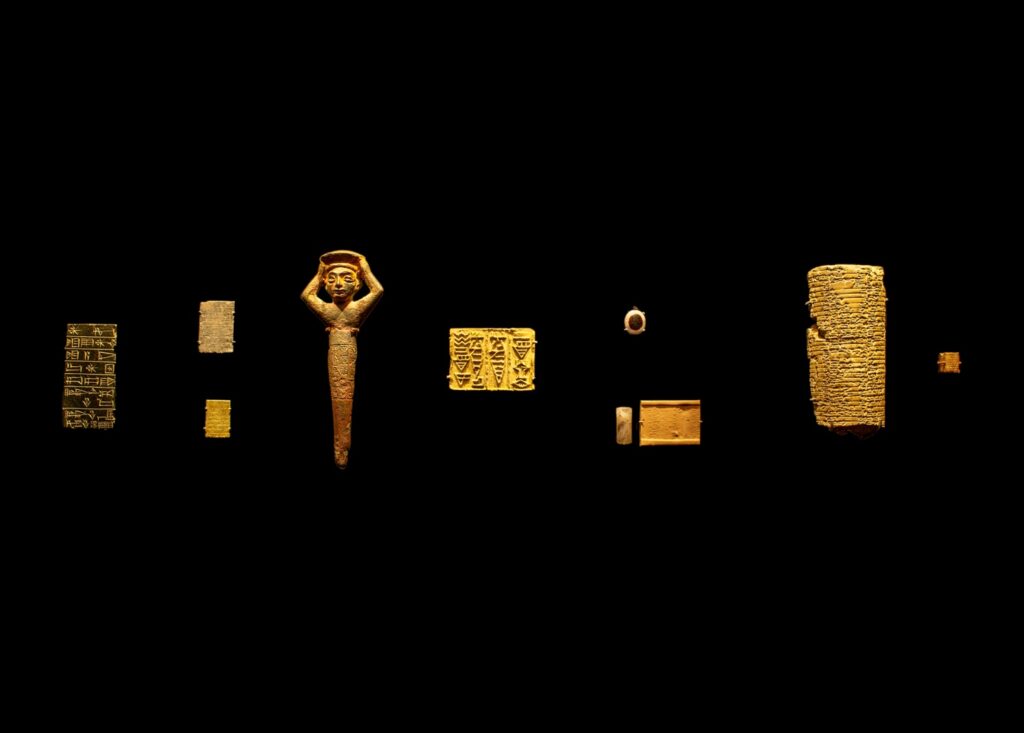
Object 1: Stone Foundation Tablet of Ur-Nammu
Steatite
Ur III period, reign of Ur-Nammu (c. 2110–2093 BC)
Possibly from Uruk
YPM BC 002577
MLC 2629
Object 2: Two Foundation Tablets
Gold and silver
Neo-Assyrian period, reign of Assurnasirpal II
(883–859 BC)
Apqu (Tell Abu Marya)
YPM BC 016991, YPM BC 016992
YBC 2398, YBC 2399
Object 3: Foundation Figurine Dedicated to Ninmarki
Cast bronze
Second Dynasty of Lagash (c. 2200–2100 BC),
reign of Ur-Ningirsu I
Possibly from Lagash
YPM BC 016871
YBC 2248
Object 4: Brick Stamp
Clay
Old Akkadian period, reign of Shar-kali-sharri
(c. 2217–2192 BC)
YPM BC 016914
YBC 2310
Object 5: Eyestone Dedicated to Ninlil
Agate
Old Babylonian period, reign of Lipit-Eshtar
(c. 1870–1860 BC)
Possibly from Nippur
YPM BC 016969
YBC 2374
Object 6: Cylinder Seal with a Prayer to Marduk
Milky agate
With rolled out impression on polymer
Kassite period (c. 1590–1155 BC)
YPM BC 006190
NBC 3217
Object 7: Large Cylinder with a Name List
Clay
Probably Ur III period (c. 2100–2000 BC)
YPM BC 016757
YBC 2124
Object 8: A Duplicate of the Name List Written in Minute Script
Clay
Probably Ur III period (c. 2100–2000 BC)
Nippur
YPM BC 014052
NBC 11202
Panel: Organizing Cuneiform Characters
The number of cuneiform signs that were actually in use differed from period to period and from genre to genre. This tablet is a full inventory of signs used by scholars of the early second millennium BC for Sumerian literary texts. The list is ordered by the shape of the signs.
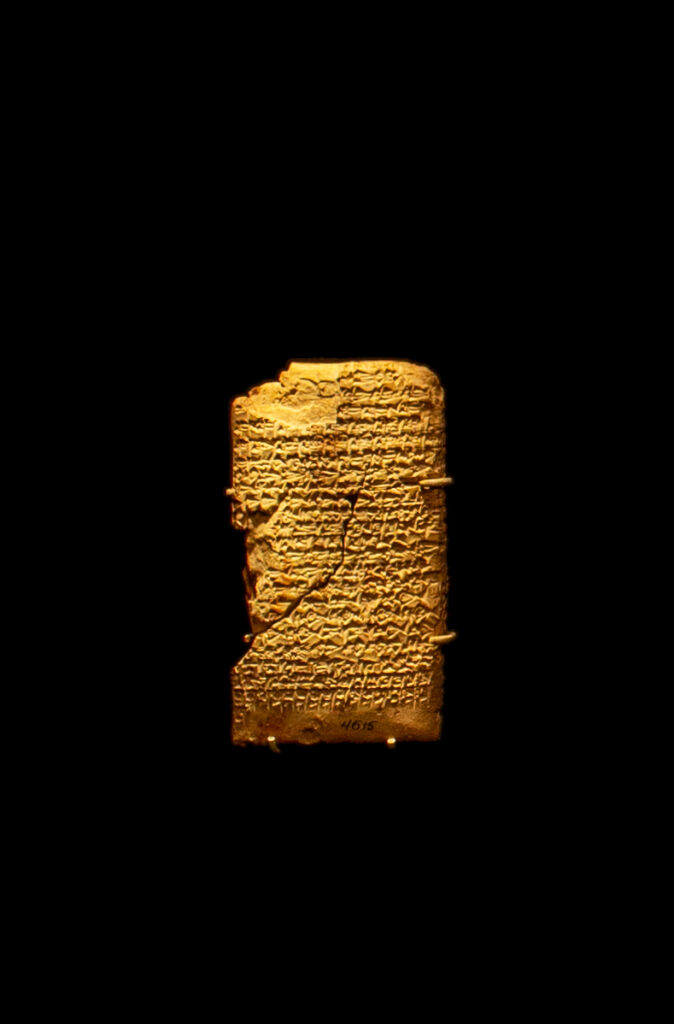
A Handbook of Signs
Clay
Old Babylonian period (c. 1900–1600 BC)
Possibly from Larsa
YPM BC 018680
YBC 4615
Panel: Rediscovery and Decipherment
The latest cuneiform text we have was written in AD 75. With exploration of ancient ruins from the eighteenth century onward, cuneiform inscriptions reemerged. Old Persian texts from Persepolis were the first deciphered. Major excavations at Nineveh and Nimrud by Austen Henry Layard and others led, by 1857, to the decoding of Babylonian and Assyrian cuneiform.
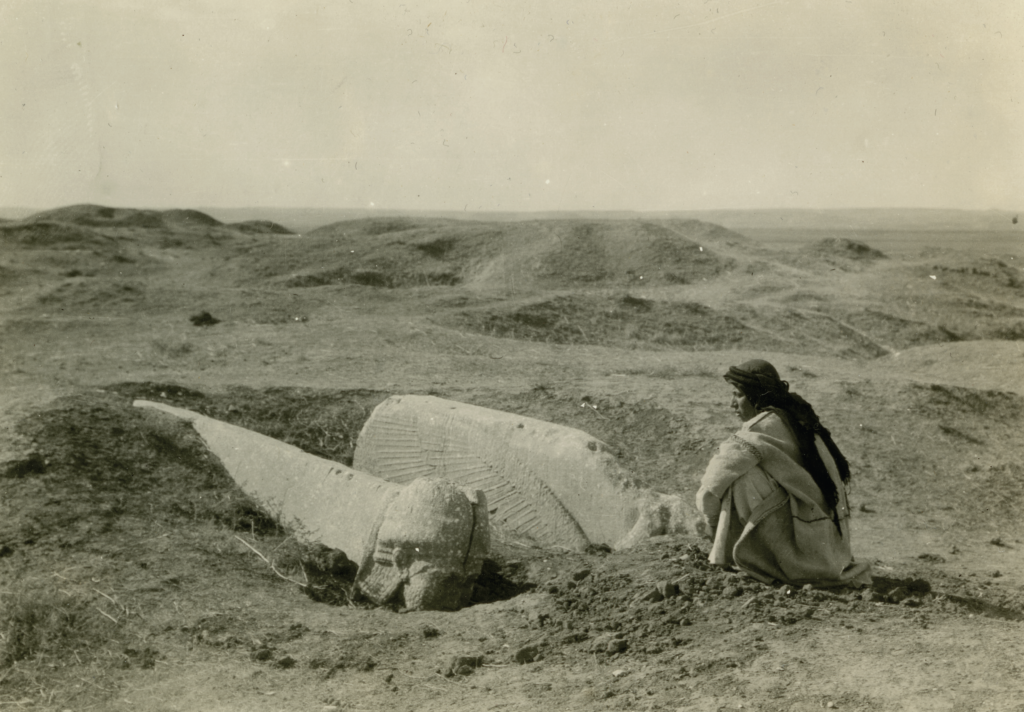
At the Ruins of Nimrud, 1920 Yale Babylonian Collection Archives
Missing image
Object: Sketch of a Winged Colossus
Ink on paper
Austen Henry Layard (1817–1894)
AD 1857
England
YPM BC 038106
YBC 10192
Layard, the first to excavate Nineveh and Nimrud, made this sketch during one of his many stays with his cousin Lady Charlotte at her home Canford Manor in Dorset, England. The drawing may show one of the large stone sculptures of human-headed winged bulls and lions on display there.

Object: Vase with Inscription in Five Scripts
Alabaster
Achaemenid period, reign of Xerxes (485–464 BC)
YPM BC 016756
YBC 2123
The name and titles of Xerxes are inscribed here in Old Persian, Elamite, and Akkadian cuneiform, and in Egyptian hieroglyphs. A fifth inscription in Demotic, a late Egyptian script, gives the capacity of the vase.

Object: Restored Interior of an Assyrian Palace
Printed cotton canvas with overpainting
Artist unknown
AD 1852
England
Anonymous loan
This was one of a series of illustrations commissioned by the British Working Men’s Educational Union for use in public lectures about Assyrian sites and arti acts excavated by Austen Henry Layard.
SECTION 2: HEROES, GODS AND DEMONS
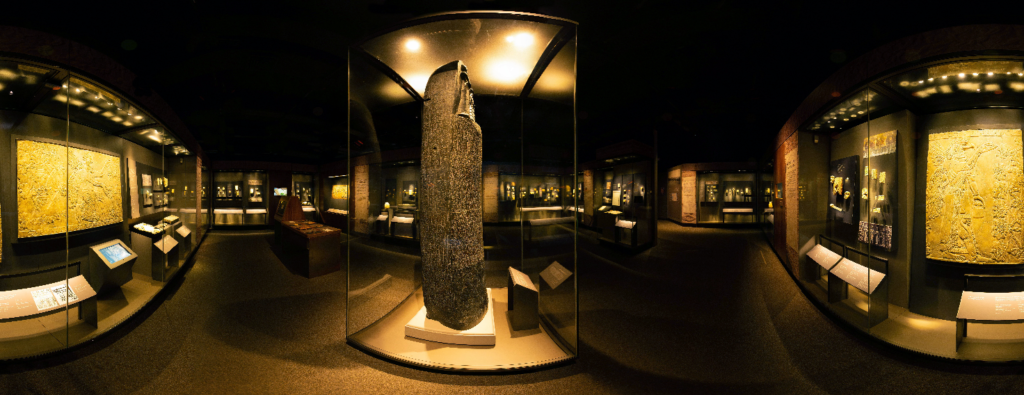
For the people of ancient Mesopotamia the world was full of supernatural beings. Gods and monsters fought epic battles that decided the rise and fall of cities, states, and dynasties. The supernatural and human worlds were closely connected and the divine realm directly influenced human existence.
The Mesopotamians believed in many gods, smaller ones who were personal deities and the greater gods of myths and legends. Heroes, such as the famed Gilgamesh, boasted super-human strength and partly divine ancestry. Evil demons inflicted illness, death, and misfortune, whereas benevolent ones provided support against such calamities.
Panel: Gilgamesh
Mesopotamia’s most famous heroic king, Gilgamesh, is the protagonist of many Sumerian and Akkadian literary works. His journey to slay the monstrous Humbaba (earlier Huwawa) and his quest for eternal life fascinated ancient Mesopotamians and also resonate with audiences today. The account of the Deluge in the Gilgamesh epic intriguingly parallels the biblical story of Noah and the Flood.
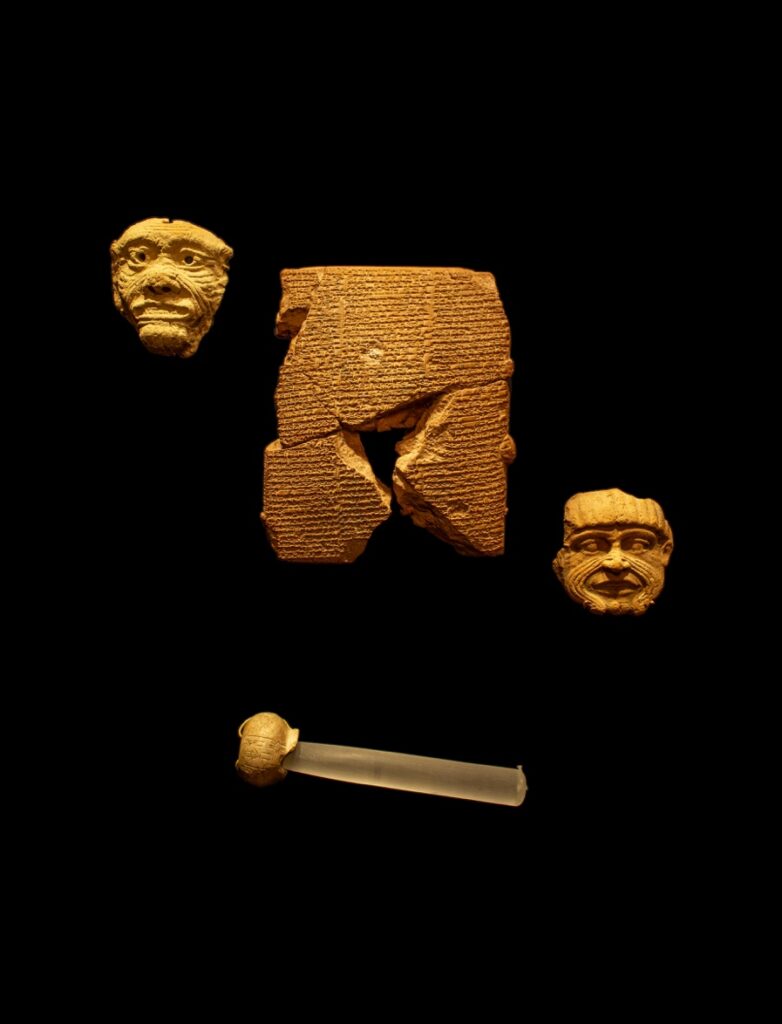
Object 1: Humbaba Mask
Terracotta
Old Babylonian period (c. 1900–1600 BC)
YPM BC 007441
NBC 4465
Object 2: “Gilgamesh and the Cedar Forest”
Clay
Old Babylonian period (c. 1900–1600 BC)
Probably from Larsa
YPM BC 016806
YBC 2178
Object 3: Humbaba Mask
Terracotta
Old Babylonian period (c. 1900–1600 BC)
YPM BC 038065
YBC 10066
Object 4: Macehead Dedicated to Gilgamesh
Limestone
Early Dynastic IIIb period (c. 2540–2350 BC)
Possibly from Girsu
YPM BC 016772
YBC 2144
Panel: Ishtar, Goddess of Love and War
The Sumerian Inana, Ishtar in Akkadian, represented love and war, ascended to heaven and descended to the netherworld, and embodied transvestism and a topsy-turvy world. She owed her position not to marriage, but to her own qualities. “The Exaltation of Inana,” an early text celebrating the goddess, is by the princess Enhedu-ana (twenty-third century BC), the first recorded author in human history.
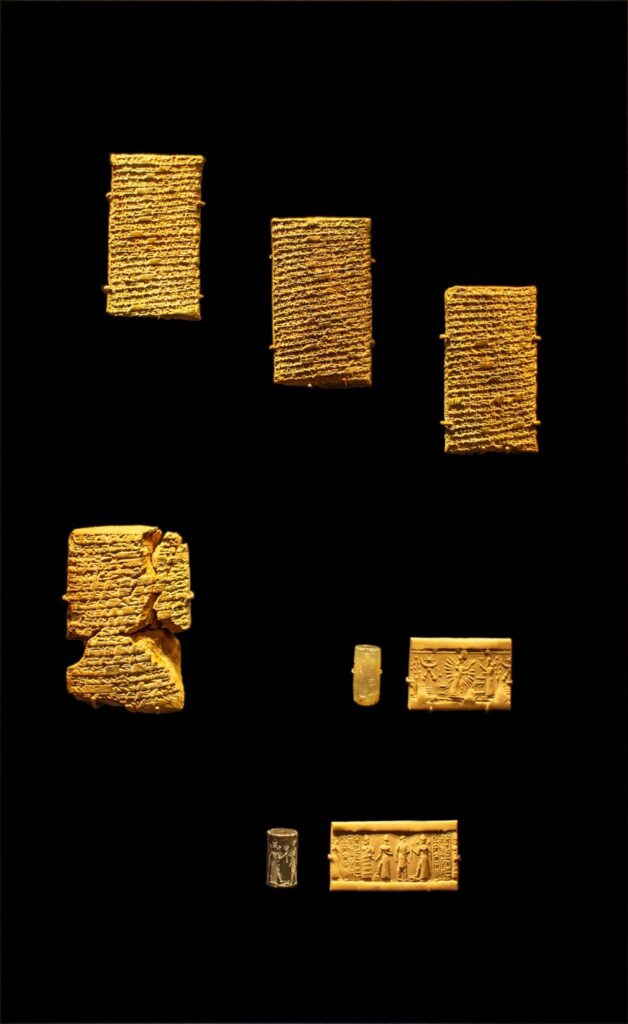
Object 1: “The Exaltation of Inana,” Part I
Clay
Old Babylonian period (c. 1900–1600 BC)
Probably from Larsa
YPM BC 018721
YBC 4656
Object 2: “The Exaltation of Inana,” Part II
Clay
Old Babylonian period (c. 1900–1600 BC)
Probably from Larsa
YPM BC 021234
YBC 7169
Object 3: “The Exaltation of Inana,” Part III
Clay
Old Babylonian period (c. 1900–1600 BC)
Probably from Larsa
YPM BC 021231
YBC 7167
Object 4: A Love Song from Inana for Dumuzi
Clay
Old Babylonian period (c. 1900–1600 BC)
YPM BC 013883
NBC 10923
Object 5: Cylinder Seal Showing Divine Ishtar
Chalcedony
Above is a digitally rolled out image of this seal with rolled out impression on polymer
Neo-Assyrian period (934–612 BC)
YPM BC 038108 NBC 12332
Object 6: Cylinder Seals Showing Ishtar as a Warrior and the Sun-god
Hematite
Below is a digitally rolled out image of this seal with rolled out impression on polymer
Old Babylonian period (c. 1900–1600 BC)
YPM BC 037115 NCBS 218
Panel: Supernatural Beings on Assyrian Reliefs
Assyrian palaces were adorned with monumental stone slabs carved with religious motifs and historical scenes commemorating military achievements. Popular under the ninth century BC king Assurnasirpal II were scenes of protective spirits and a “sacred tree.” The two relief fragments here come from a palace room used for purification and cleansing rituals.

Carved Relief Showing Standing Eagle-headed Genius Facing a “Sacred Tree”
Alabaster
Neo-Assyrian period, reign of Assurnasirpal II
(883–859 BC)
Nimrud, North-West Palace, Room I
Yale University Art Gallery
YUAG 1854.3
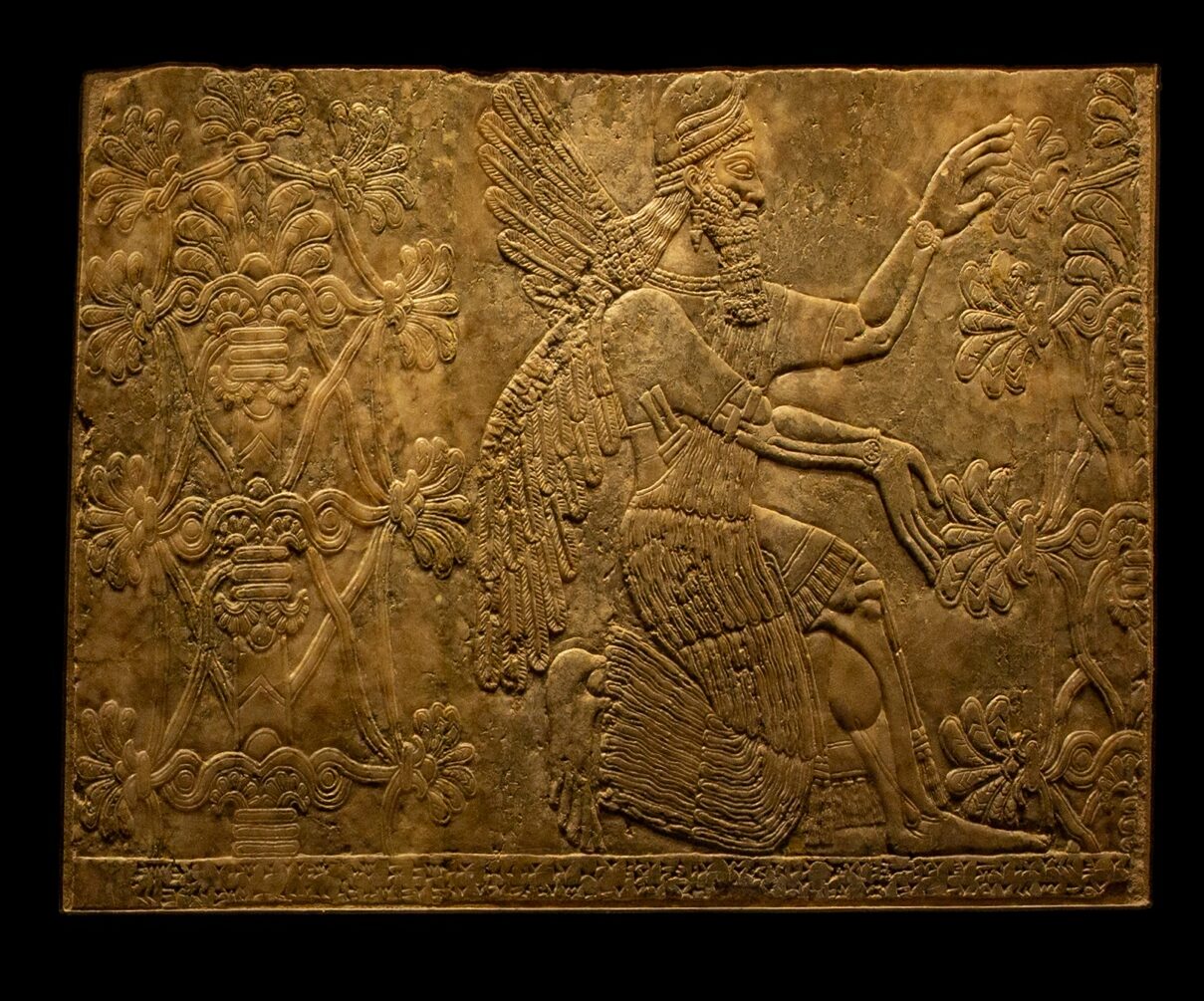
Carved Relief Showing Kneeling Human-headed Genius Facing a “Sacred Tree”
Alabaster
Neo-Assyrian period, reign of Assurnasirpal II
(883–859 BC)
Nimrud, North-West Palace, Room I
Yale University Art Gallery
YUAG 1854.4, YUAG 1854.5
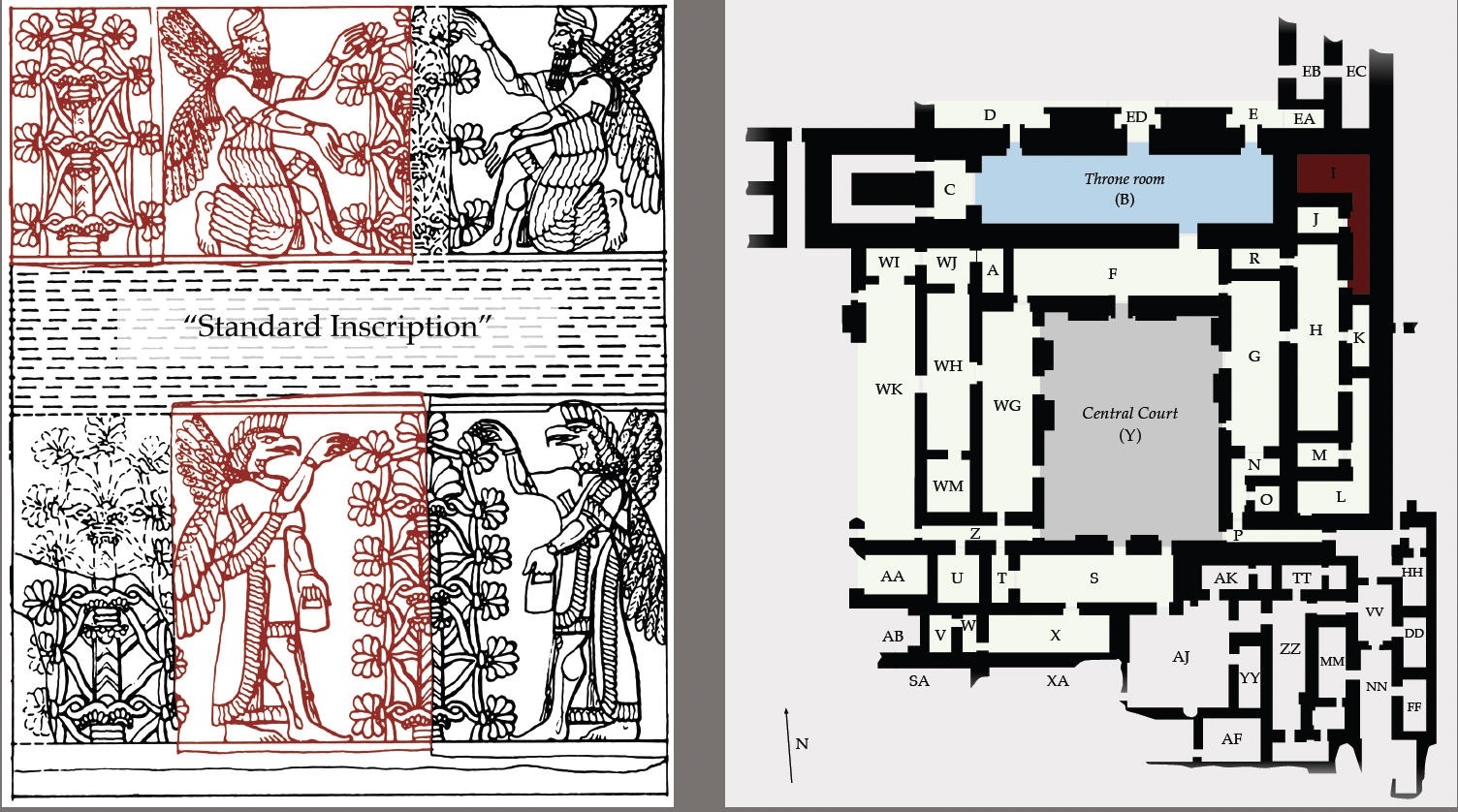
Left
Slab from Room I with the two relief fragments on display marked in red.
Right
Layout of the North-West Palace with Room I marked in red.
Panel: Monsters, Demons, and Genies
Mesopotamian monsters and demons usually had no families and played no role in the temple cult. Half human and half animal, they inhabited a space between the divine and the human. Monsters were associated with gods and heroes, demons and benevolent genies interacted mainly with humans and the natural world.
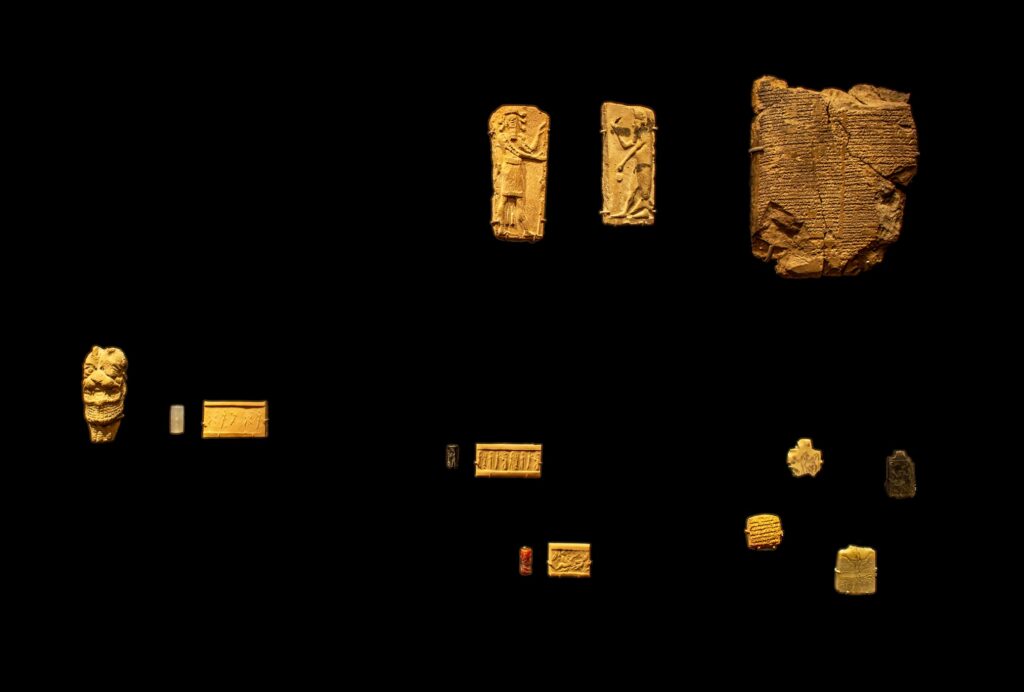
Object 1: Head of the Demon Pazuzu, Protector against Evil
Clay
Probably Late Babylonian period (second half of the first millennium BC)
Nippur
YPM BC 016825
YBC 2197
Object 2: Cylinder Seal Showing the Demons Pazuzu, Lulal, and Ugallu
Blue chalcedony
Above is a digitally rolled out image of this seal with rolled out impression on polymer
Neo-Babylonian period (first half of the first millennium BC)
YPM BC 026360
YBC 12601
Object 3: Plaque Depicting a “Hero with Six Curls”
Clay
Middle Assyrian period (c. 1400–1000 BC) or Neo-Assyrian
period (c. 934–612 BC)
Possibly Assur
YPM BC 038025
YBC 10086
Object 4: Plaque with a “Fish-apkallu,”a Protective Spirit
Clay
Neo-Assyrian period (934–612 BC)
YPM BC 038026
YBC 10168
Object 5: Incantations against Evil Demons
Clay
Late Babylonian period (second half of the first millennium BC)
YPM BC 004279
NBC 1307
Object 6: Cylinder Seal Showing Battles between Humans and Demons
Hematite
With rolled out impression on polymer
Old Babylonian period (c. 1900–1600 BC)
YPM BC 037054
NCBS 157
Object 7: Monsters Fighting
Carnelian
With rolled out impression on polymer
Neo-Babylonian period (first half of the first millennium BC)
YPM BC 023720
YBC 9668
Object 8: An Incantation against the Child-snatching Demoness Lamashtu
Clay
Old Assyrian period (c. 2000–1700 BC)
Central Anatolia
YPM BC 006647
NBC 3672
Object 9: An Amulet against Lamashtu
Marble
Second millennium
YPM BC 016821
YBC 2193
Object 10: An Amulet against Lamashtu
Alabaster
Late second millennium
Allegedly from Uruk
YPM BC 005502
NBC 2529
Object 11: An Amulet against Lamashtu
Obsidian
Late second or early first millennium
YPM BC 011147
NBC 8151
Panel: The Mesopotamian Pantheon
Mesopotamian religion was polytheistic with countless divine beings. Religious texts mention many gods organized in families and supplied with their own personnel. Some gods were patrons of cities. The moon god Sin resided over Ur and the goddess of love and war, Ishtar, over Uruk.

Object: A List of Thousands of Gods
Clay
Middle Assyrian period (c. 1400-1000 BC)
Assur
YPM BC 016994
YBC 2401
Panel: Gods Visible and Invisible
Deities were often worshipped in Mesopotamia in the form of human-shaped statues that wore clothes and jewelry. Sometimes divine symbols and “emblems of emptiness” replaced such anthropomorphic representations, indicating a belief in the invisibility of certain aspects of the world of the gods.

From left to right
Object: Letter Reporting a Theft in a Temple of the God Assur
Clay
Old Assyrian Period (c. 2000–1700 BC)
Kanesh, Anatolia
YPM BC 009599
NBC 6615
Object: Plaque with Temple Façade and Seated Deity
Clay
Old Babylonian period (c. 1900–1600 BC)
YPM BC 038109
YBC 10035
Object: Plaque with Temple Façade
Clay
Old Babylonian period (c. 1900–1600 BC)
YPM BC 016771
YBC 2143
Object: Ornamental Footrest for a Deity
Chlorite
Late third millennium
Possibly from eastern Iran
YPM BC 016999
YBC 2407
SECTION 3: DAILY LIFE
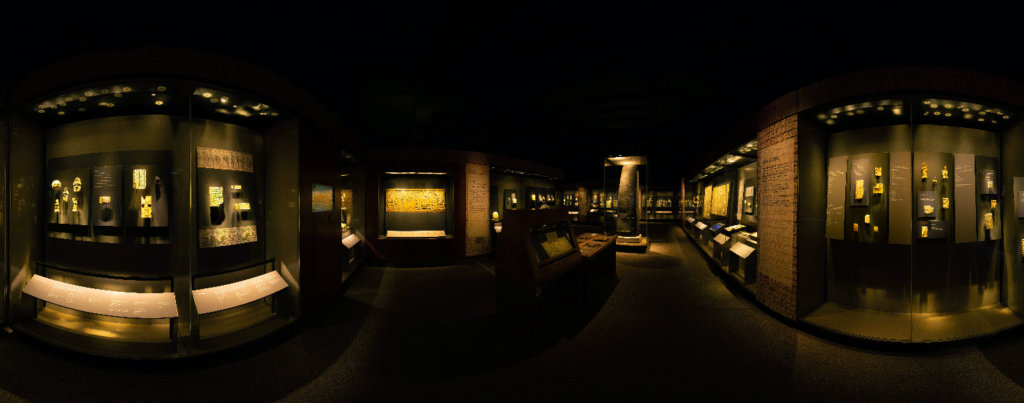
The people of ancient Mesopotamia fell in love and married, enjoyed music, games, and cooking, and interacted with animals and pets. Like us today, they also had to cope with family conflicts, childlessness, adultery, divorce, and death.
People lived their lives as members of small family households, typically a father and a mother, children, and sometimes grandparents. Slaves owned by well-off families would also belong to the household.
Men occupied different professions, from farmer to seal-cutter. Women were legally entitled to own property, enter contracts, and engage in business, but many tended to stay at home. Others worked in the fields, or were tavern keepers, midwives, or priestesses.
Panel: Love
Mesopotamian men and women often sought to secure another’s affections through magic and incantations. Terracotta plaques celebrate erotic attraction with graphic depictions of lovemaking. Some show a man approaching a woman bent at the waist and sipping beer through a drinking tube. The exact function of the plaques is debated.

Object: List of Love Incantations
Clay
Late Babylonian period, late fourth century
Uruk
YPM BC 001857
MLC 1859
Top right
Object: Mold with Erotic Scene
Clay
Old Babylonian period (c. 1900–1600 BC)
YPM BC 007452
NBC 4476
Bottom right
Object: Plaque with Erotic Scene
Clay
Old Babylonian period (c. 1900–1600 BC)
YPM BC 016962
YBC 2367
Panel: Marriage
Marriage between men and women was as fundamental a social institution in ancient Mesopotamia as it is today. A marriage contract stipulated the conditions of the union. Most were monogamous, but if a wife remained childless or the partners had a permanent long-distance relationship, a man could take a second wife.
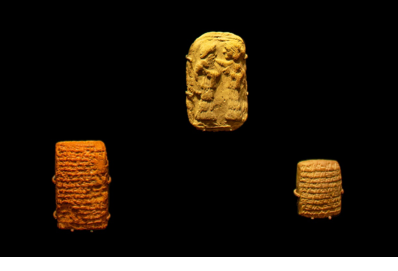
Left to right
Object: Legal Document for the Marriage between Nabu-ahu-usur and Tala-Uruk
Clay
Neo-Babylonian period, 512
Uruk
YPM BC 017797
YBC 3732
Object: Plaque Showing an Embracing Couple
Clay
Old Babylonian period (c. 1900–1600 BC)
YPM BC 038111
YBC 10025
Object: Letter from Lamassi to Her Husband Pushu-ken
Clay
Old Assyrian period (c. 2000–1700 BC)
Kanesh, Anatolia
YPM BC 006791
NBC 3816
Panel: Children
Married couples were eager to have children, to care for them in old age and provide funerary offerings after death. Often sons took up the profession of their fathers. With no male heir, a man could take a second wife or the couple could adopt. Figurines and texts relate caring relationships between generations.
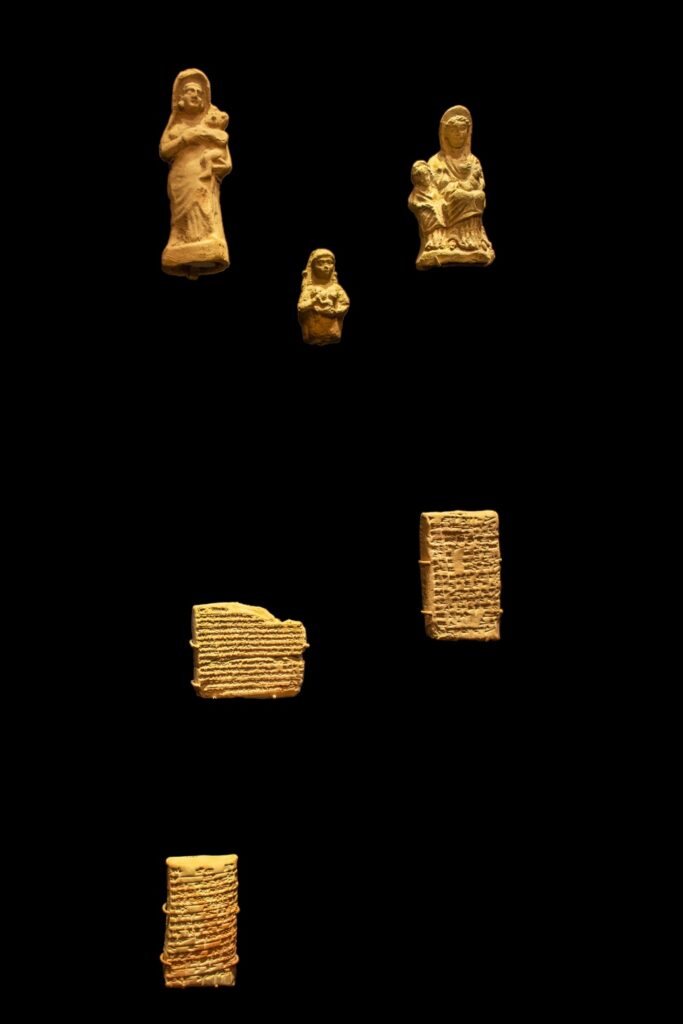
Object 1: Figurine of a Mother and Her Child
Clay
Hellenistic period (331–141 BC) or
Parthian period (141 BC – AD 224)
YPM BC 038110
YBC 10059
Object 2: Figurine of a Mother and Her Child
Clay
Neo-Babylonian period (first half of the first millennium BC)
YPM BC 016846
YBC 2223
Object 3: Figurine of a Mother and Her Child
Clay
Hellenistic period (331–141 BC) or
Parthian period (141 BC – AD 224)
YPM BC 007427
NBC 4451
Object 4: Ritual to Quiet a Child
Clay
Late Babylonian period (second half of the first millennium BC)
Possibly from Nippur
YPM BC 009132
NBC 6151
Object 5: Adoption Contract
Clay
Old Babylonian period, c. 1743
Possibly from Ur
YPM BC 004244
NBC 1272
Object 6: A Letter to Mom
Clay
Old Babylonian period (c. 1900–1600 BC)
Possibly from Larsa
YPM BC 008268
NBC 5289
Panel: Adultery, Divorce, and Death
Every unhappy family is unhappy in its own way. Wedded couples in Mesopotamia would experience major troubles when one of the partners engaged in adultery. There might be a divorce. And when people died, the division of their estates did not always prove easy.
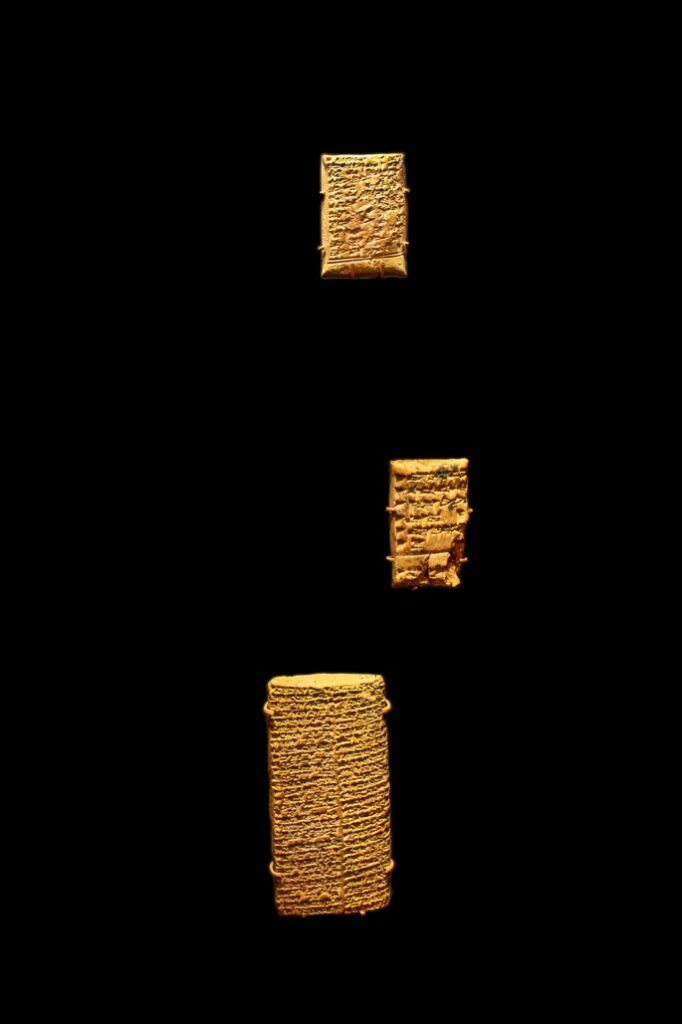
Object: Riddle about an Adulterer
Clay
Old Babylonian period (c. 1900–1600 BC)
YPM BC 019893
YBC 5828
Object: Legal Statement Recording a Divorce
Clay
Old Babylonian period, probably eighteenth century
Possibly from Larsa
YPM BC 036445
NCBT 1900
Object: Legal Document about Brothers Sharing an Inheritance
Clay
Old Babylonian period, c. 1816–1794
Possibly from Isin
YPM BC 008321
NBC 5341
Panel: Music and Entertainment
Like today, music, sports, and games were part of everyday life. Some of these activities had ritual significance and some were just for fun. We have musical scores from the second millennium BC, but they are difficult to interpret. A few instruments and board games have been preserved in the archaeological record.
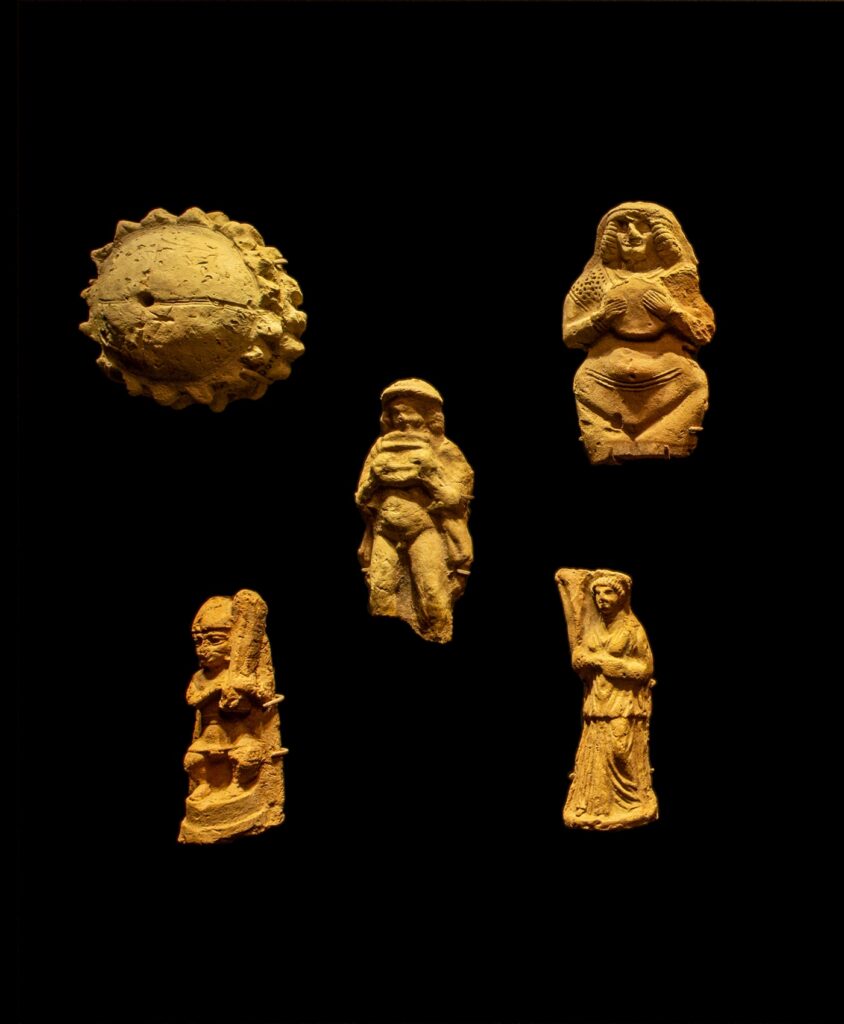
Object 1: Pie Crust Rattle
Clay
Third or early second millennium
YPM BC 023979
YBC 10043
Object 2: Nude Male Figurine Holding a Tambourine
Clay
Hellenistic period (331–141 BC) or
Parthian period (141 BC – AD 224)
YPM BC 016862
YBC 2239
Object 3: Nude Female Figurine Holding a Tambourine at Her Chest
Clay
Old Babylonian period (c. 1900–1600 BC)
YPM BC 023976
YBC 10001
Object 4: Dwarf Playing a Harp
Clay
Hellenistic period (331–141 BC) or
Parthian period (141 BC – AD 224)
YPM BC 016852
YBC 2229
Object 5: Female Musician Playing a Harp
Clay
Hellenistic period (331–141 BC) or
Parthian period (141 BC – AD 224)
YPM BC 016826
YBC 2198
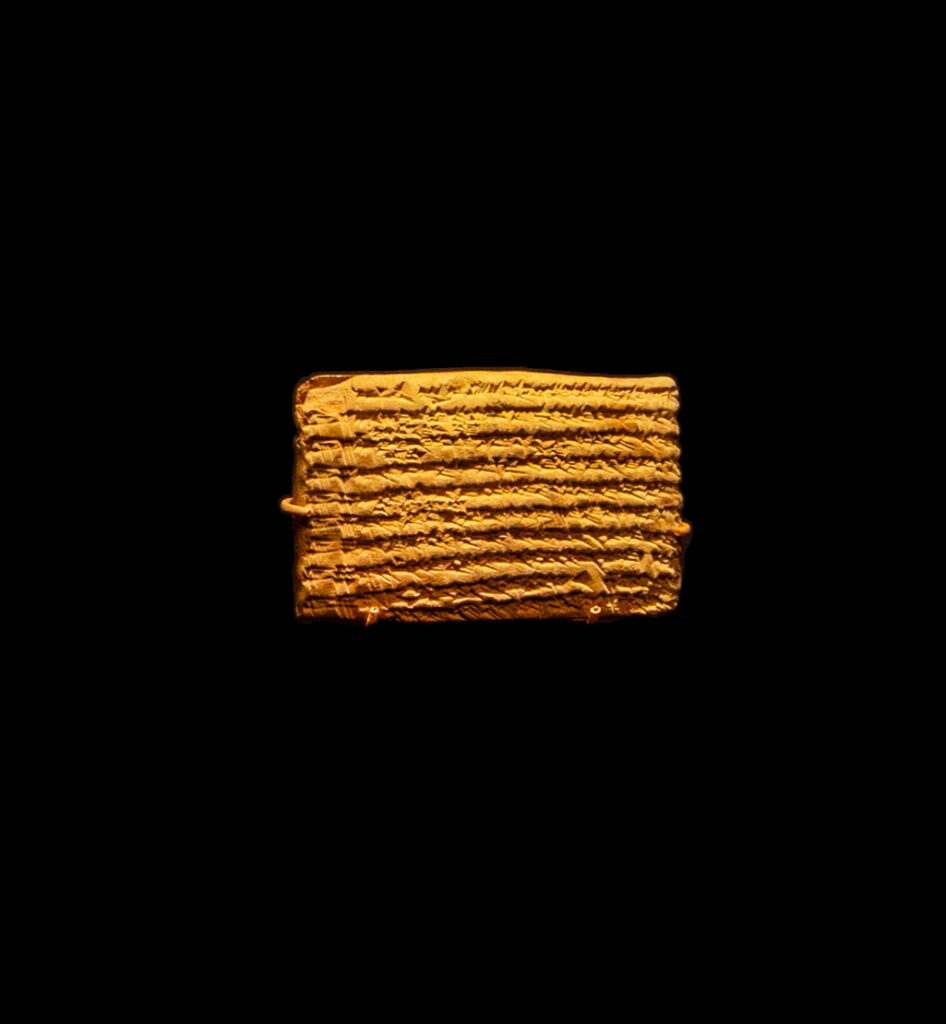
Object 6: Text Exploring the Religious Dimensions of the Strings of the Lyre
Clay
Late Babylonian period
(second half of the first millennium BC)
Possibly from Uruk
YPM BC 025175
YBC 11381
The tablet lists the words of several short prayers, each related to a particular string of the lyre. The prayers may have been chanted to the pitch of the respective string.
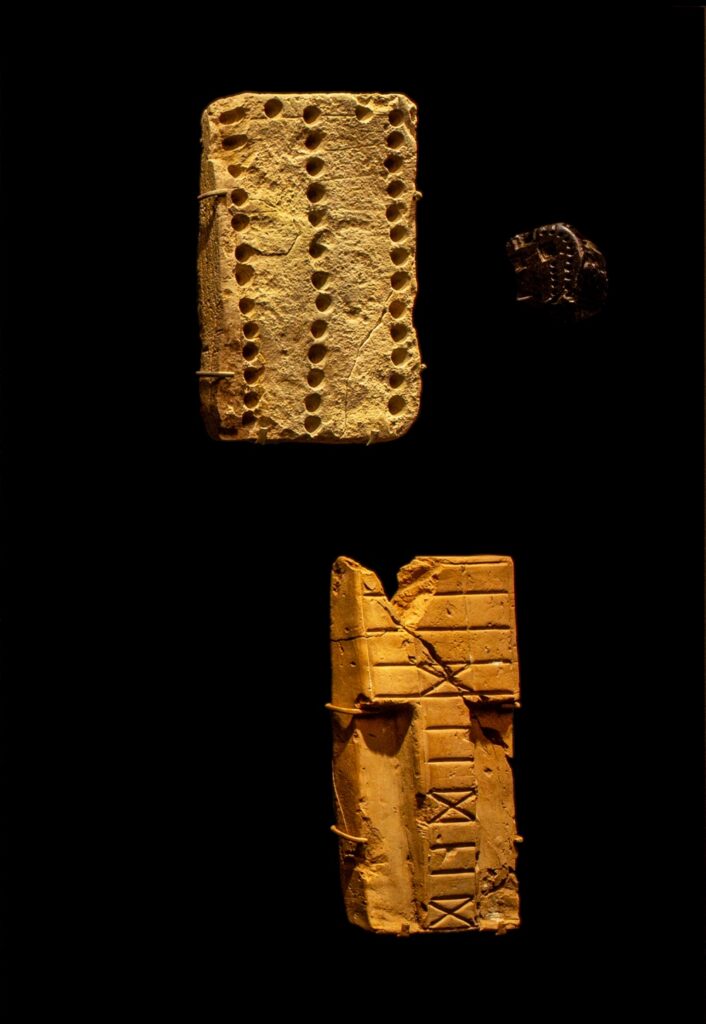
Object 7: A Game with Forty-one Holes
Clay
Probably Old Babylonian period
(c. 1900–1600 BC)
YPM BC 038044
YBC 10089
Object 8: The Game of Fifty-eight Holes
Serpentine
Probably Old Babylonian period
(c. 1900–1600 BC)
YPM BC 017030
YBC 2439
Object 9: The Game of Twenty Squares
Clay
Probably Old Babylonian period
(c. 1900–1600 BC)
YPM BC 038112
YBC 2396
Panel: Cooking
Many of our most important food staples originated in the Near East, including barley and wheat, and animals such as cows, sheep, and pigs. The world’s oldest written recipes, recorded in southern Mesopotamia around 1700 BC, are instructions for stews and pies. They reveal a sophisticated kitchen that used many different cooking techniques.
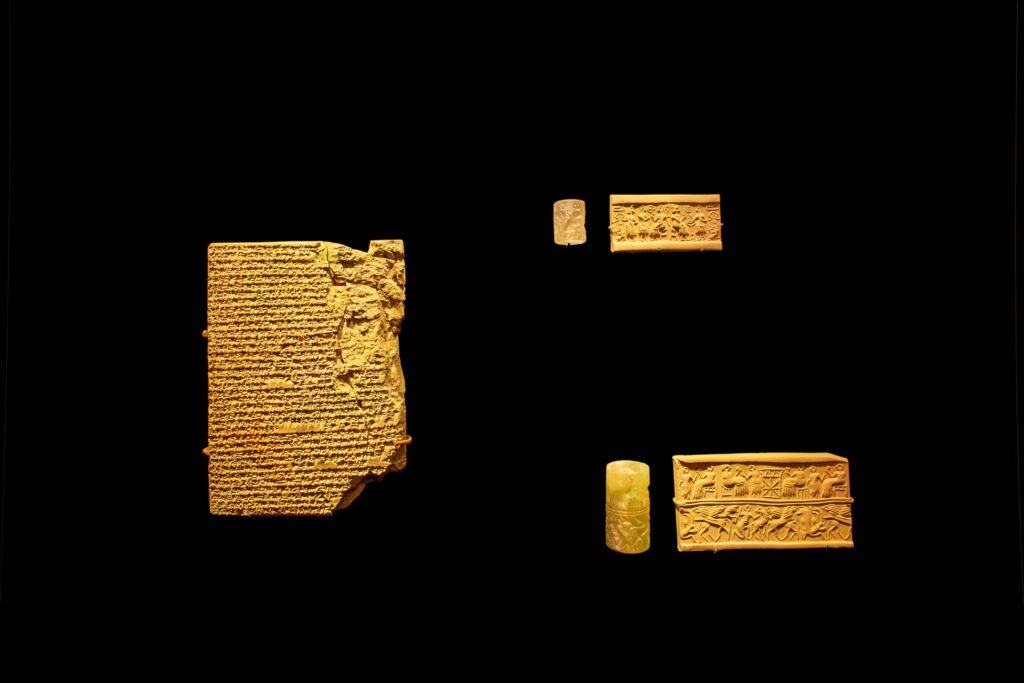
Object: A Babylonian Cookbook
Clay
Old Babylonian period (c. 1900–1600 BC)
Possibly from Larsa
YPM BC 018709
YBC 4644
Objects: Two Cylinder Seals Showing Banquet Scenes
Rock crystal
Green calcite
With rolled out impression on polymer and a digitally
rolled out image of each seal
Early Dynastic III period (2600–2350 BC)
YPM BC 023974
YBC 9991
YPM BC 008968
NBC 5987
(Recipe no. 9) Pashrutu-dish
Meat is not used. You prepare water. You add fat. (You add) kurrat, cilantro, salt as desired, leek, garlic. You pound up dried sourdough, you sift (it) and you scatter (it) over the pot be ore removing it.
(Recipe no. 12) Lamb Stew
Meat is used. You prepare water. You add fat. You add fine-grained salt, dried barley cakes, onion, Persian shallot, and milk. You [crush] (and add)
leek and garlic.
(Recipe no. 16) Elamite Broth
Meat is not used. You prepare water. You add fat. Dill, kurrat, cilantro, leek, and garlic bound with blood, a corresponding amount of sour milk, and (more) garlic. The (original) name of this dish is Zukanda.
(Recipe no. 17) Wild-pigeon Broth
You split up the wild pigeon; (other) meat is (also) used. You prepare water. You add fat. Fine-grained salt, dried barley cakes, onion, Persian shallot, leek, and garlic: you soak (these) herbs of yours in milk, and (the dish) is ready to serve.
(Recipe no. 22) Tuh’u-dish
Leg meat is used. You prepare the water. You add fat. You sear. You add salt, beer, onion, arugula, cilantro, Persian shallot, cumin, and red beet, and you crush leek and garlic. You sprinkle coriander from storage on top. You add kurrat and fresh cilantro.
Panel: Animals and Pets
Animals were ever-present in Mesopotamian daily life: as guardians and pets, as a source of meat, dairy products, and wool, or as dangerous predators and pests. The behavior of animals and the sounds they made could be interpreted as auspicious or inauspicious signs. Animal bites and stings required treatment.

Top to bottom
Object: A Letter Order Regarding the Feeding of Cats
Clay
Neo-Babylonian period, mid sixth century
Uruk
YPM BC 025161
YBC 11367
Object: Magic Spells against Worms, Snakes, and Scorpions
Clay
Old Babylonian period (c. 1900–1600 BC)
YPM BC 018681
YBC 4616
Object: Rituals against Ill-omened Animals in the House
Clay
Late Babylonian period (second half of the first millennium BC)
YPM BC 023872
YBC 9873
Panel: Animals in Art
Animal-shaped plaques and figurines were common. Some represent dogs, the earliest domesticated animal. Used as guardians and hunting companions, they are usually shown wearing collars. Stone weights were often shaped like a duck with its head resting on its back. They ranged from less than a tenth of an ounce (2 grams) to 12 pounds (5.5 kilograms).
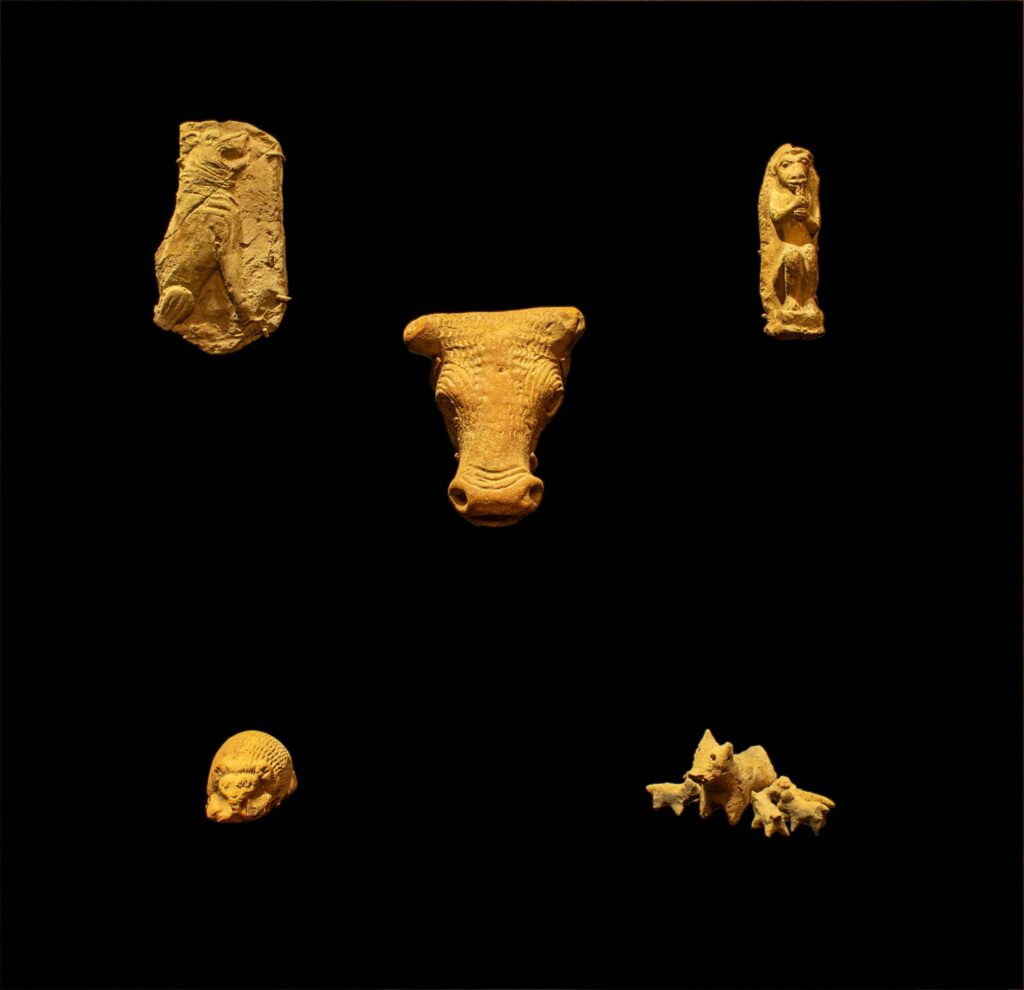
Left to right
Object: Plaque Showing a Snarling Dog
Clay
Neo-Assyrian period (934–612 BC)
YPM BC 038113
NBC 12112
Object: Hedgehog Figurine
Clay
Period unknown
YPM BC 038116
YBC 10072
Object: Head of a Bull with Greek Inscription
Clay
Hellenistic period (331–141 BC) or later
YPM BC 038115
YBC 10090
Object: Piglets and Mother Pig
Clay
Period unknown
YPM BC 031220
RBC 926
Object: A Monkey with Two Flutes
Clay
Possibly Hellenistic period (331–141 BC)
Probably Babylon
YPM BC 016854
YBC 2231
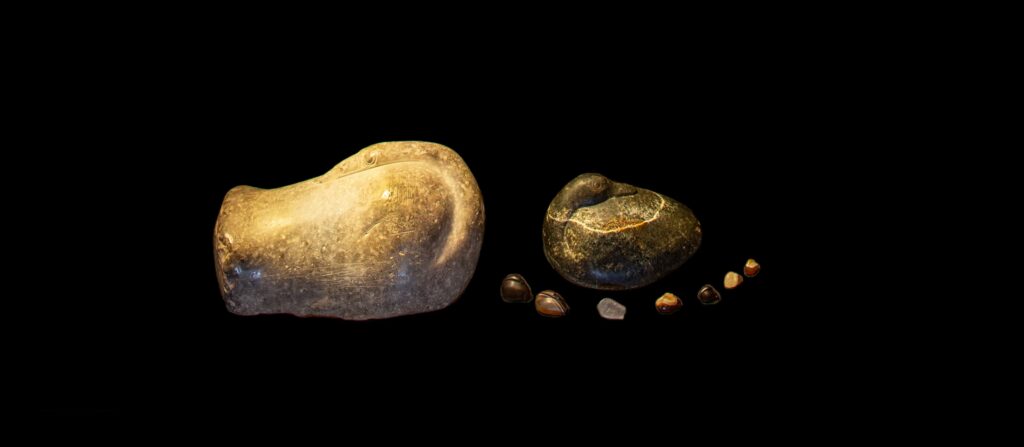
Objects on Pedestal: A Group of Duck Weights
Hematite, agate, limestone, and chalcedony weighing from 0.07 ounces (2 grams) to 12 pounds (5.5 kilograms)
Late third to late first millennium
YPM BC 037779, YPM BC 032059,
YPM BC 038125, YPM BC 023972,
YPM BC 038126, YPM BC 012512,
YPM BC 009015, YPM BC 016883,
YPM BC 016815
NCBS 882, RBC 1766, YBC 9983, NBC 9519,
NBC 6034, YBC 2262, YBC 2187
Panel: Assurbanipal Banqueting with His Queen
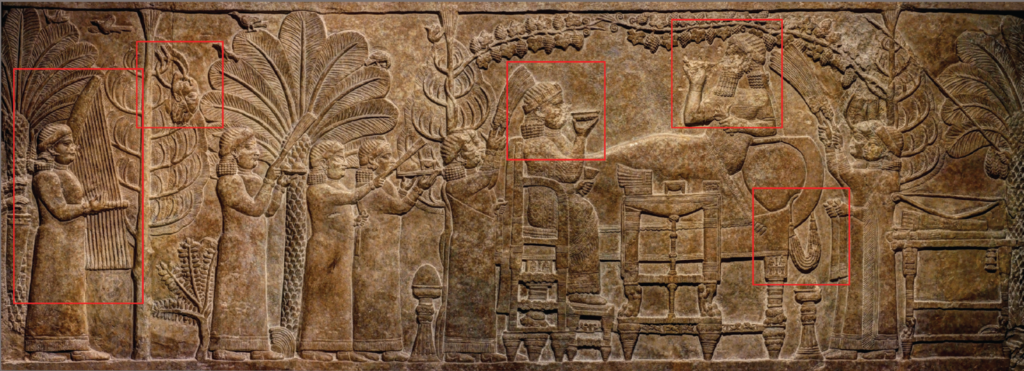
Object: Bas-relief from the North Palace at Nineveh
Plaster cast
Early twentieth century
YPM BC 038054
Original in the British Museum
BM 124920
This well-known bas-relief shows the Assyrian king Assurbanipal (668–631 BC) banqueting with his wife Libbali-sharrat beneath a vine in a garden at Nineveh. The scene includes several remarkable details.
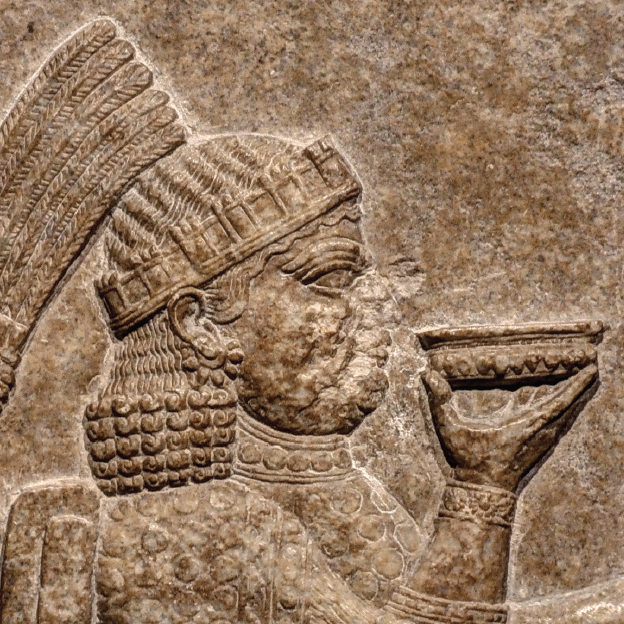
Detail of the Assyrian Queen:
Libbali-sharrat, shown here wearing a mural crown, studied the scribal arts like her husband Assurbanipal.
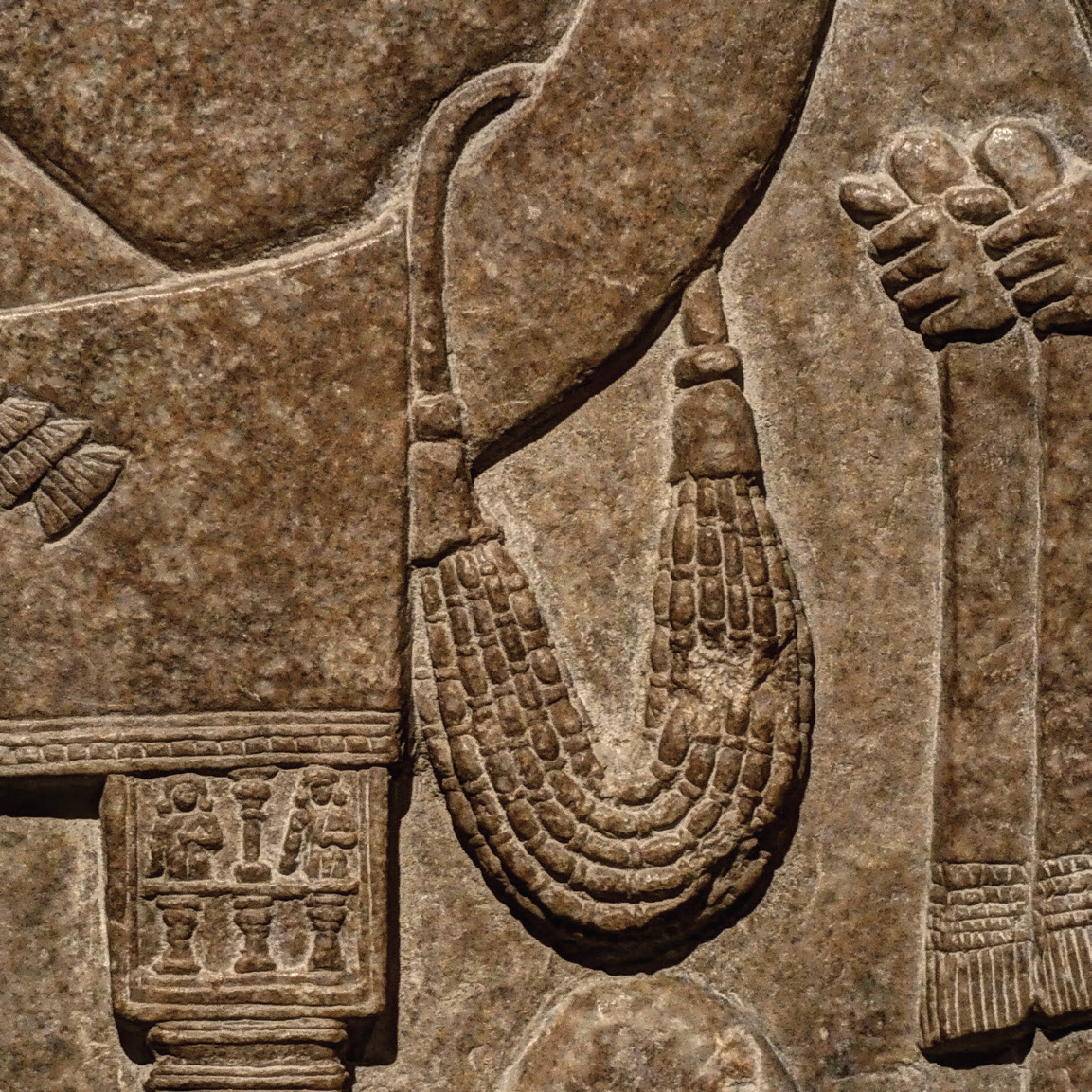
Detail of the Necklace:
Possibly Egyptian, the necklace slung over the royal couch may be a protective charm.
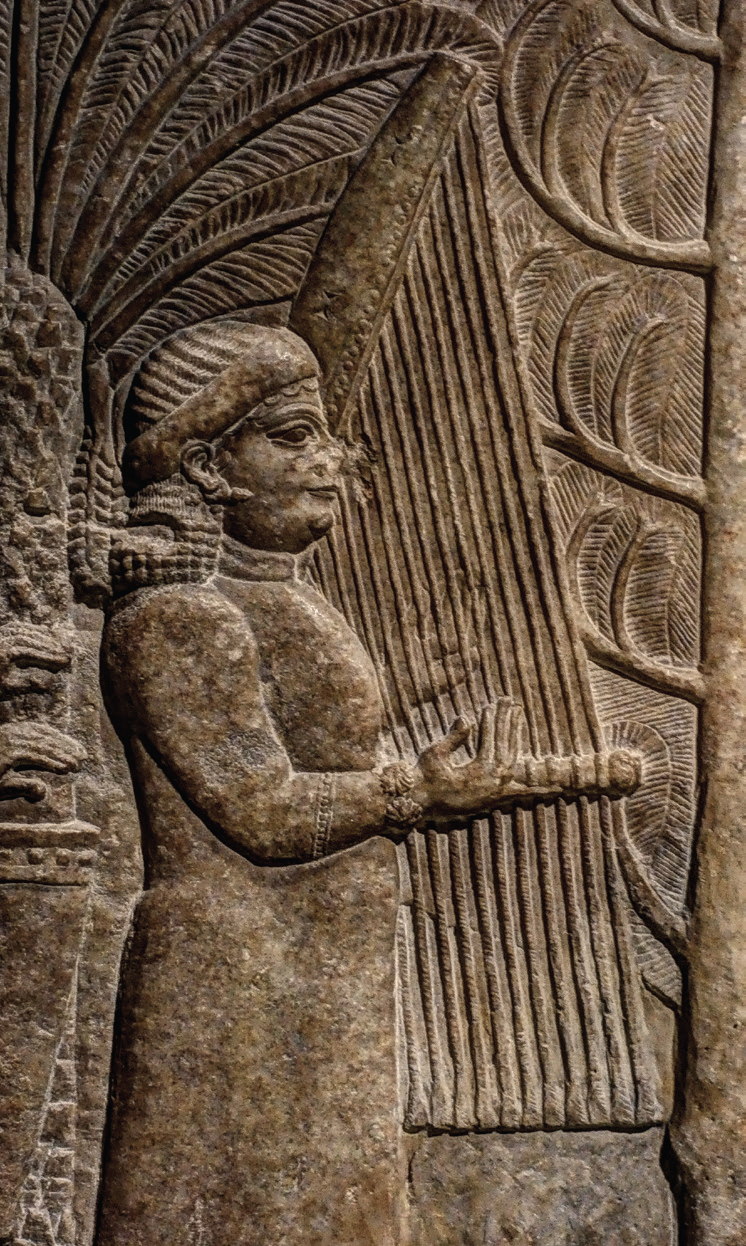
Detail of the Musicians:
The royal couple is entertained by several musicians, one playing a large harp.
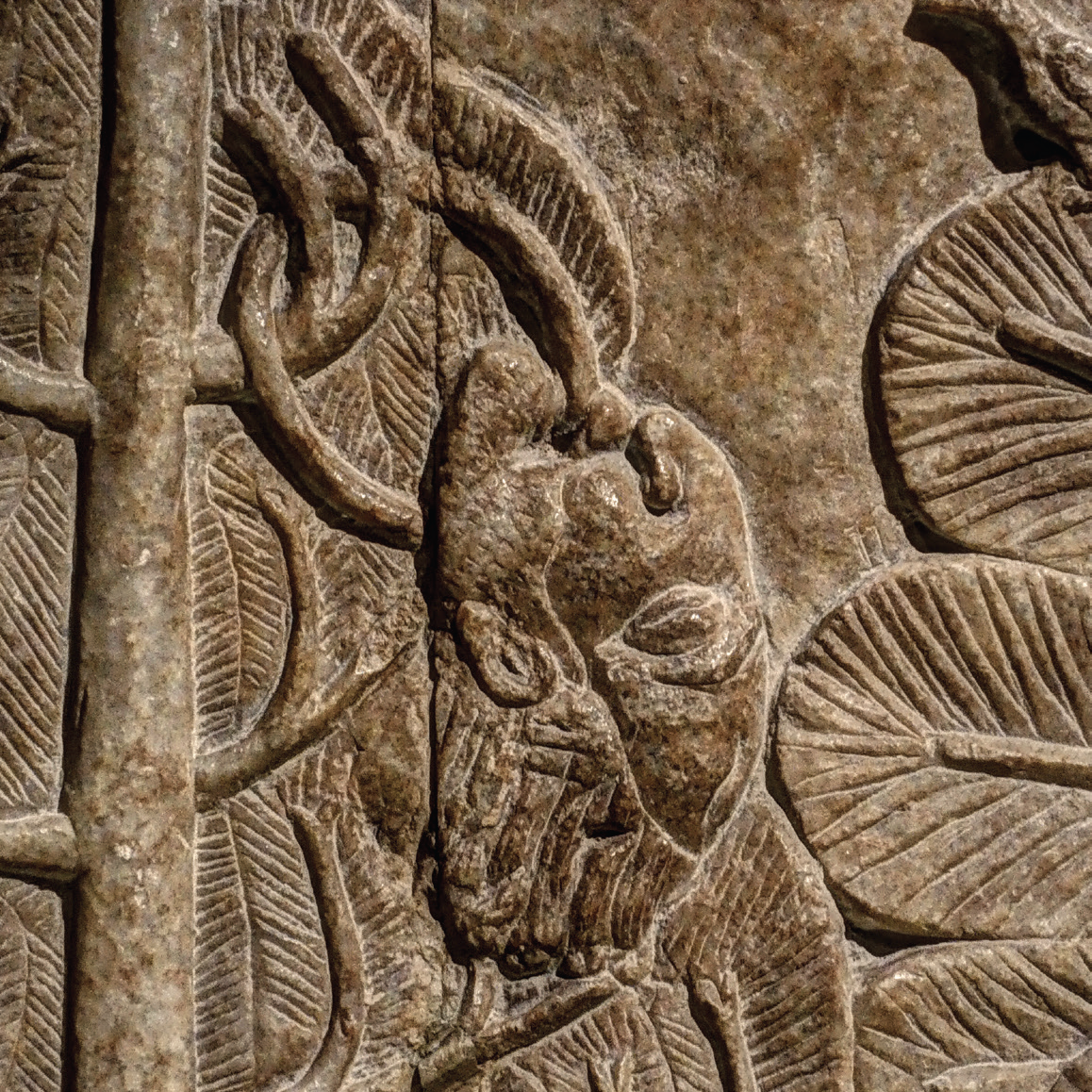
Detail of the Head in the Tree:
The Elamite king Teumman had once threatened the Assyrians, “I shall not [sleep(?)] until I have come and dined in the center of Nineveh.” In the end, it was Assurbanipal who dined there, with Teumman’s head (recognizable by its receding hairline) hanging from a nearby tree.
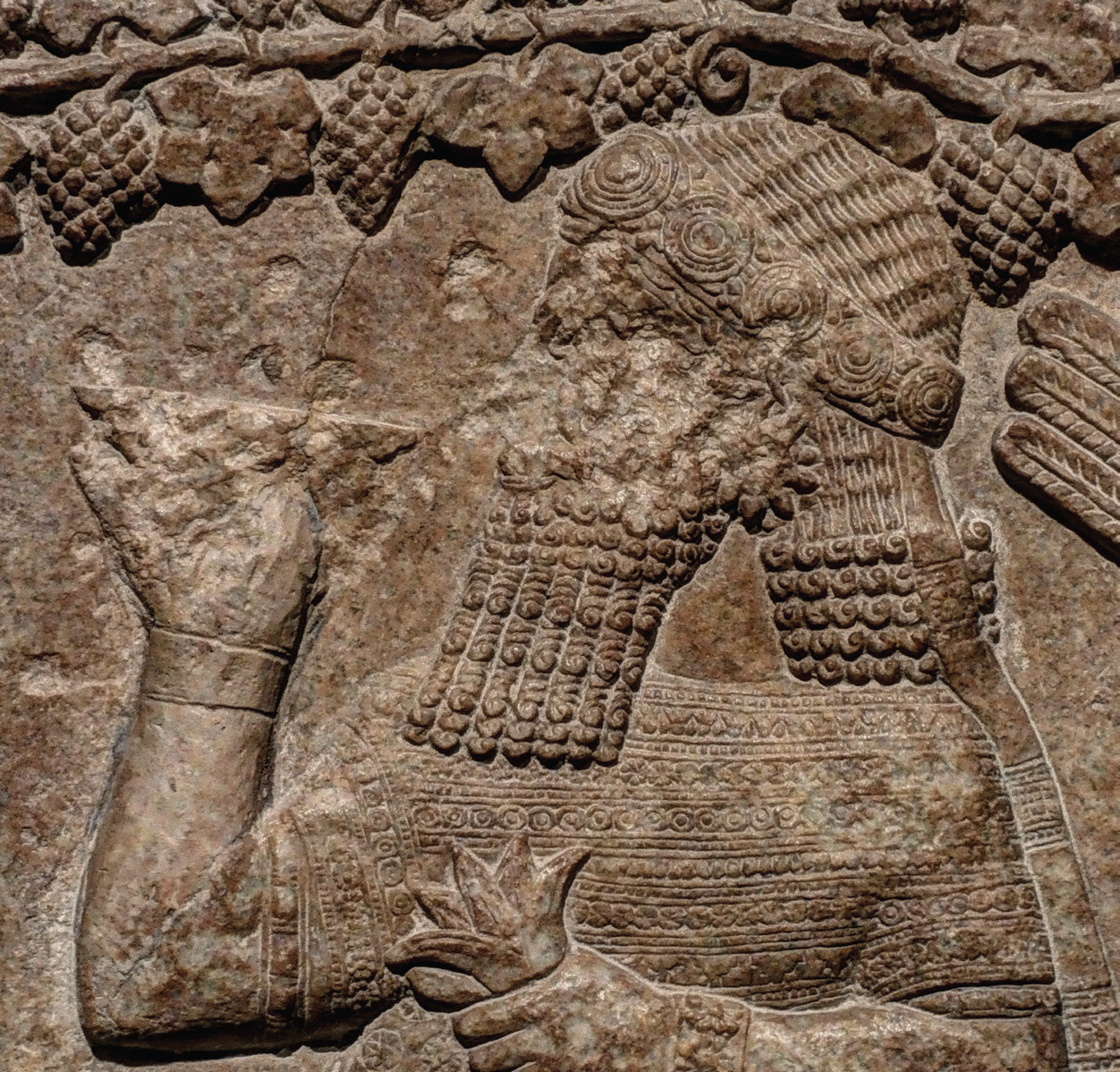
Detail of Assurbanipal’s Head:
The image of the Assyrian king was deliberately mutilated when the Medes and Babylonians conquered Nineveh in 612 BC.
SECTION 4: KINGS, CRIMINALS, AND CONSPIRATORS
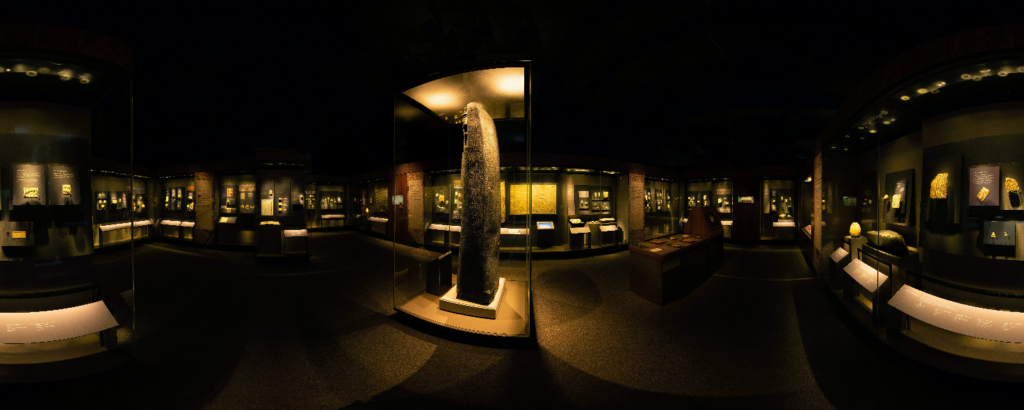
Ancient Egypt and Mesopotamia gave birth to the earliest complex states in history.
Both civilizations emerged along the shores of major rivers, which enabled the establishment of central governments headed by kings. These monarchs wielded enormous power. They waged war against other states, fortified their borders and cities with walls, engaged in diplomacy, built temples, and produced the earliest collections of laws known from anywhere in the world.
Yet they were never able to completely eliminate criminal behavior, corruption, and subversion. Mesopotamian legal documents and letters show that people committed all sorts of crimes, from murder to theft to smuggling. Mesopotamians also criticized and ridiculed their rulers, and occasionally engaged in acts of rebellion against them.
Panel: Fighting for Land and Resources
For long stretches of its history, Mesopotamia was divided into several independent states. These often waged war as territory needed to be protected against outside forces and access to water and other resources had to be secured. The century-long conflict between the neighboring city states of Umma and Lagash is particularly well documented.
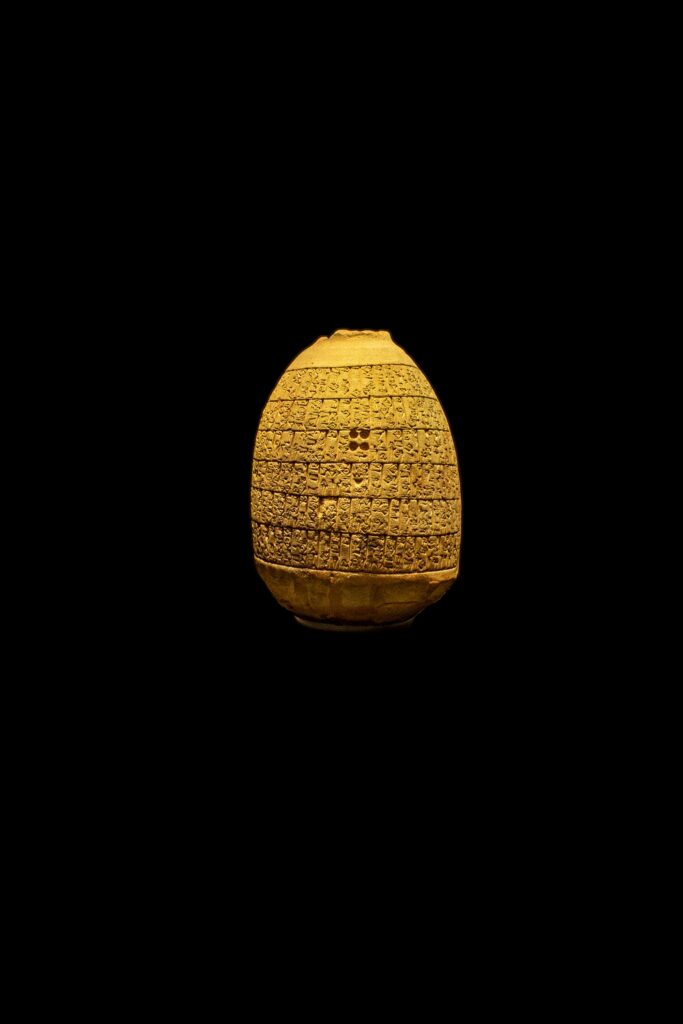
Object: Royal Inscription Describing the Umma-Lagash Border Conflict
Clay
Early Dynastic IIIb period, reign of Enmetena of Lagash (c. 2403–2375 BC)
Girsu
YPM BC 005474
NBC 2501
Panel: Building a Wall
In the mid twenty-first century BC, King Shu-Suen of Ur built a wall along his northern border to keep out the semi-nomadic Amorites known as Tidnum. They broke through eventually, but instead of establishing a barbarian regime as feared, the newcomers adapted to Mesopotamian civilization, inaugurating one of the most fruitful eras in Mesopotamian history.
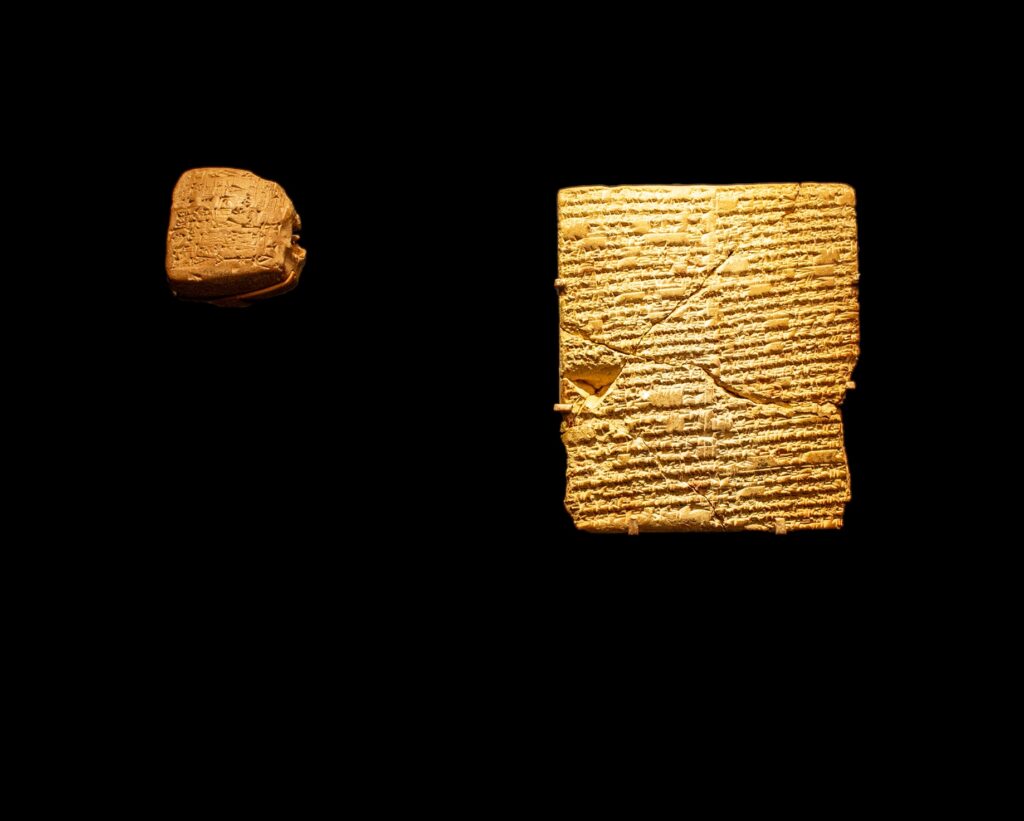
Above left
Object: Tag with a Shu-Suen Year-name Related to the Tidnum Wall
Clay
Ur III period, twenty-ninth day of the second month, c. 2031
Umma
YPM BC 002256
MLC 2309
Above right
Object: Letters from Shu-Suen’s Correspondence about the Tidnum Wall
Clay
Old Babylonian period (c. 1900–1600 BC)
Southern Babylonia
YPM BC 021213
YBC 7149
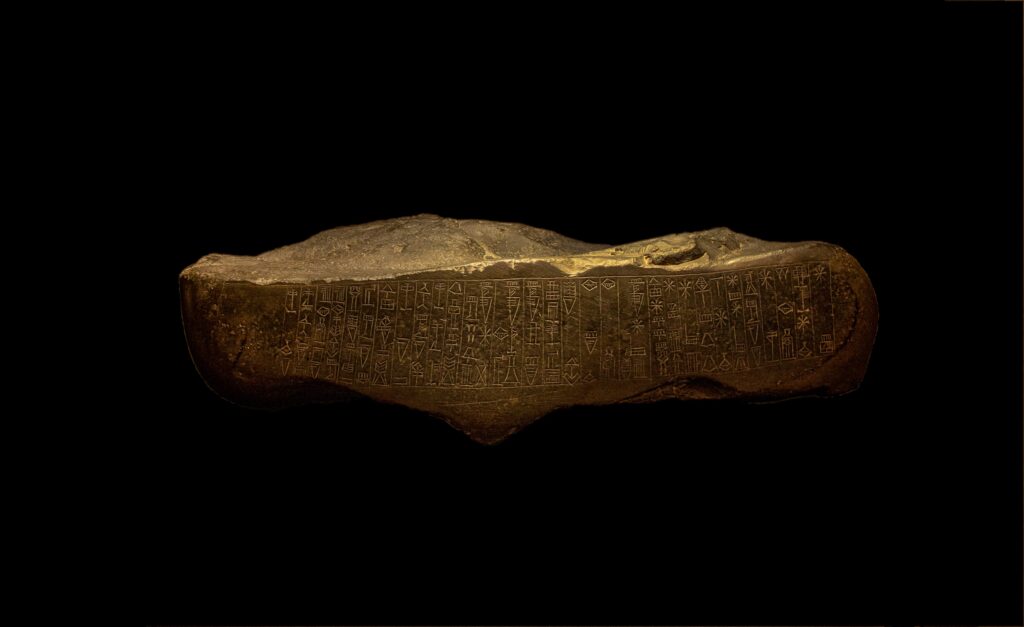
Object on pedestal: Door Socket with Inscription Mentioning the Tidnum Wall
Diorite
Ur III period, reign of Shu-Suen (2035–2027 BC)
Umma
YPM BC 016763
YBC 2130
Panel: Law, Crime, and Punishment
Several rulers from the mid third millennium BC onward—including Hammurabi o Babylon—created collections of laws. Even though they are never directly quoted in legal documents, these collections set the stage for a lawful life. Still, crimes and other violations o the social order continued, as many texts show.
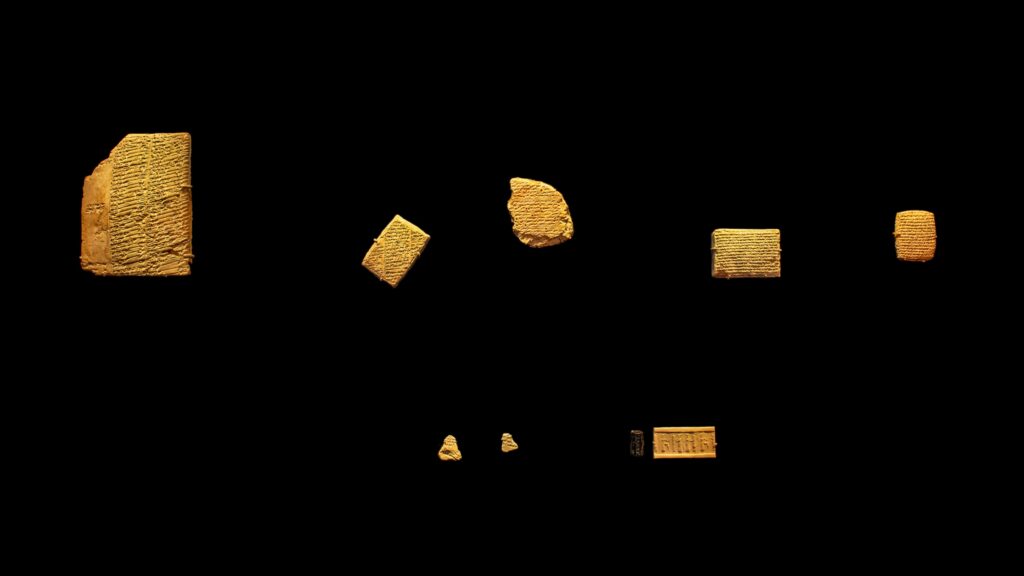
Object 1: Sumerian Laws
Clay
Old Babylonian period
(c. 1900–1600 BC)
YPM BC 016805
YBC 2177
Object 2: A Tablet Inscribed with Hammurabi’s
Laws
Clay
Old Babylonian period (c. 1900–1600 BC)
YPM BC 020582
YBC 6516
Object 3: Assyrian Palace Edicts concerning
Royal Women
Clay
Middle Assyrian period, reign o Tiglath-pileser I (1114–1076 BC)
Assur
YPM BC 021212
YBC 7148
Objects 4 and 5: Fragments of Hittite Laws
Clay
Hittite New Kingdom period (c. 1430–1180 BC)
Possibly from Hattusha, Anatolia
YPM BC 014649, YPM BC 014662
NBC 11803, NBC 11816
Object 6: Judicial Document about a Prison
Break
Clay
Persian period, January 529
Uruk
YPM BC 021009
YBC 6943
Object 7: Letter from an Old Assyrian Smuggler
Clay
Old Assyrian period (c. 2000-1700 BC)
Kanesh, Anatolia
YPM BC 004658
NBC 1685
Object 8: Cylinder Seal Showing the Sun-god, the Protector of Justice
Serpentine
With rolled out impression on polymer
Old Akkadian period (c. 2350–2150 BC)
YPM BC 037969
NBC 12229
Panel: Corresponding with Kings
Letters are among the most revealing texts that have survived from the ancient Near East. Royal letters are often about international politics, questions of prestige, and the exchange of precious goods and skilled experts. Letters to kings from officials can be fawning, but illustrate well the challenges of running the affairs of state.
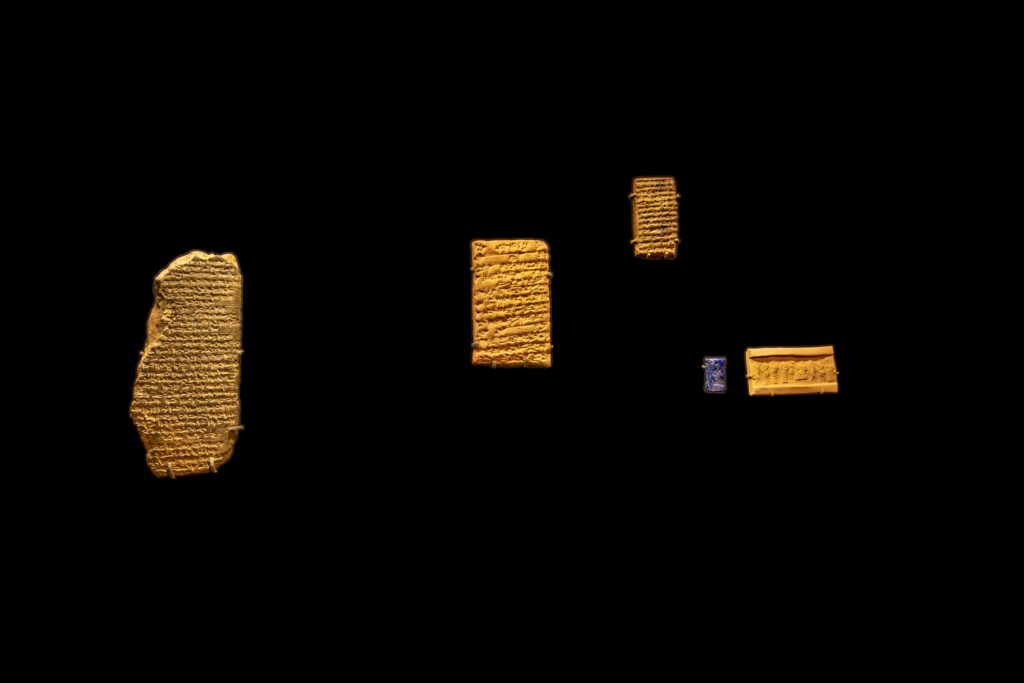
Left to right
Object: Letter from Ramesses II to the Hittite King Hattushili III
Clay
Mid thirteenth century
Hattusha, Anatolia
YPM BC 006909
NBC 3934
Object: Letter from Nebuchadnezzar II concerning Work Done by the Temple
Clay
Neo-Babylonian period, reign of Nebuchadnezzar II
(605–562 BC)
Uruk
YPM BC 021530
YBC 7464
Object: Letter from King Hammurabi concerning a Land Dispute
Clay
Old Babylonian period, reign of Hammurabi
(1790–1752 BC)
Larsa
YPM BC 023958
YBC 9959
Object: Cylinder Seal with Audience Scene
Lapis lazuli
With rolled out impression on polymer
Old Babylonian period (c. 1900–1600 BC)
YPM BC 006261
NBC 3288
Panel: Propaganda and Reality
Ancient Near Eastern kings produced thousands of images and inscriptions to depict themselves as “ideal rulers.” Letters and legal documents, however, provide a more realistic picture of the Mesopotamian political landscape: subjects often took a rather grim view of their leaders and occasionally were in open revolt against them.
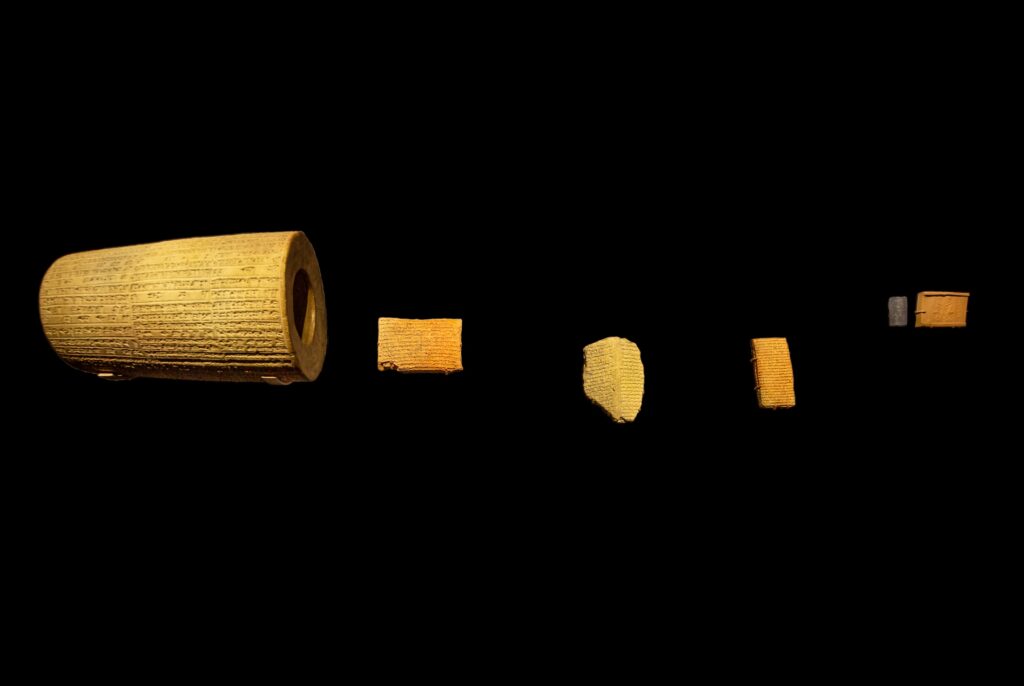
Left to right
Object: Nebuchadnezzar Praising Himself as a Great Builder
Clay
Neo-Babylonian period, reign o
Nebuchadnezzar II (605–562 BC)
Marad
YPM BC 016866
YBC 2243
Object: Esarhaddon Glorifying His Military Conquests
Clay
Neo-Assyrian period, reign of Esarhaddon
(680–669 BC)
Nineveh
YPM BC 029482
YBC 16224
Object: Cylinder Seal Showing the Ideal King
Chalcedony
With rolled out impression on polymer and a digitally rolled out image of this seal
Persian period (539–331 BC)
YPM BC 038107
YBC 8418
Object: A Case of Lèse-majesté (Treason)
Clay
Persian period, April 526
Uruk
YPM BC 018015
YBC 3950
Object: Treason and Revolt in a Letter to Esarhaddon
Clay
Neo-Assyrian period, reign of Esarhaddon
(probably 671 BC)
Probably from Nineveh
YPM BC 025176
YBC 11382
Panel: The Hammurabi Law Stele
The Code of Hammurabi is among the earliest and most important law collections from the ancient world. Written in Akkadian around 1750 BC, it contains some three hundred laws, many following the principle of “an eye for an eye.” Many copies of the code are known to have existed. The most important preserved example is in the Louvre Museum in Paris, a 7.4 foot (2.25 meter) black basalt stele excavated at Susa (Iran) in 1901. Casts of it are on display in several museums, law schools, and political institutions across the world.
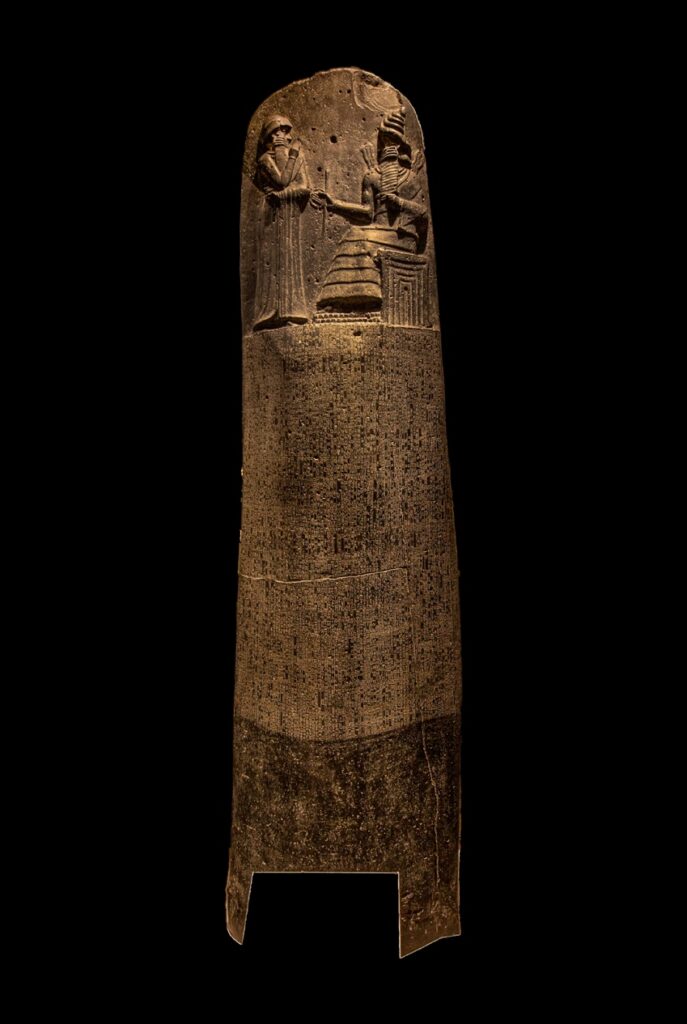
Object: Hammurabi’s Law Stele
Plaster cast
Early twentieth century AD
YPM BC 038053
Original in the Louvre Museum, Sb 8
SECTION 5: SCIENCE AND SCHOLARSHIP

Once they had acquired the fundamentals of the scribal arts, many educated Mesopotamians pursued scholarly and scientific interests, from philology and grammar to mathematics, medicine, and the “futurological” study of omens. In the first millennium BC, Babylonian astronomy reached impressive levels of sophistication.
The so-called Astronomical Diaries and related works, composed uninterruptedly between the eighth and first centuries BC, record the movements of the heavenly bodies in the night sky. Other texts engage in advanced types of computational, predictive astronomy.
Important innovations during the Persian period were the zodiac and personal horoscopes, both still in use today. The division of the hour into sixty minutes of the circle into three-hundred-sixty degrees, and the naming of many heavenly bodies and constellations, from Venus and Mars to Cancer and Taurus, can also be traced back to the Babylonians.
Panel: Becoming a Scribe
Exercise tablets, often written in a clumsy, inexperienced hand, put us in close contact with the students who attended Mesopotamian “schools.” Even though not every child had to memorize hundreds of signs and thousands of lines of text, literacy was probably fairly widespread, at least in the cities.
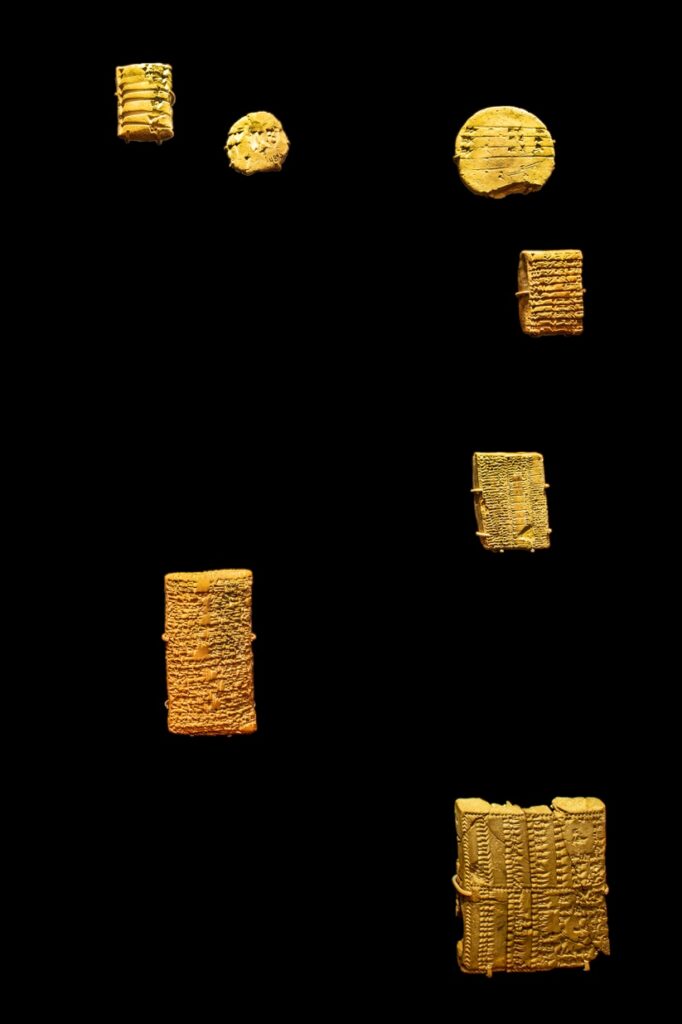
Object 1: Writing Syllables
Clay
Old Babylonian period (c. 1900–1600 BC)
YPM BC 012526
NBC 9560
Clay
Probably Old Babylonian period (c. 1900–1600 BC)
YPM BC 018959
YBC 4895
Object 3: Satire about a Father and His Mischievous Son
Clay
Old Babylonian period (c. 1900–1600 BC)
Possibly from Larsa
YPM BC 018281
YBC 4216
Object 4: Lenticular School Tablet Listing Oxen of Various Ages
Clay
Old Babylonian period (c. 1900–1600 BC)
YPM BC 021351
YBC 7286
Object 5: Economic Record Dealing with Cattle of Various Ages
Clay
Ur III period, third year of the reign of Shu-Suen (c. 2033 BC)
Drehem
YPM BC 016363
YBC 1622
Object 6: A Word List in Pocket Size
Clay
Kassite period (c. 1590–1155 BC)
YPM BC 013875
NBC 10915
Object 7: School Tablet with a Dedication to the God of Writing
Clay
Late Babylonian period (second half of the first millennium BC)
Babylon or Borsippa
YPM BC 002842
EAH 197
Above
Assyrian Scribes Writing Cunei orm on a Writing Board and Aramaic on a Leather Scroll
Neo-Assyrian period, reign of Sennacherib (704–681 BC)
British Museum
BM WA 124955
Panel: Measuring Space, Tracking Time
Mathematics and geometry were important elements of Mesopotamian culture, diligently studied by scribal students and applied to engineering projects, calendrical calculations, and other purposes. By the mid first millennium BC, mathematical astronomy was able to achieve remarkably accurate predictions of planetary movements and eclipses.
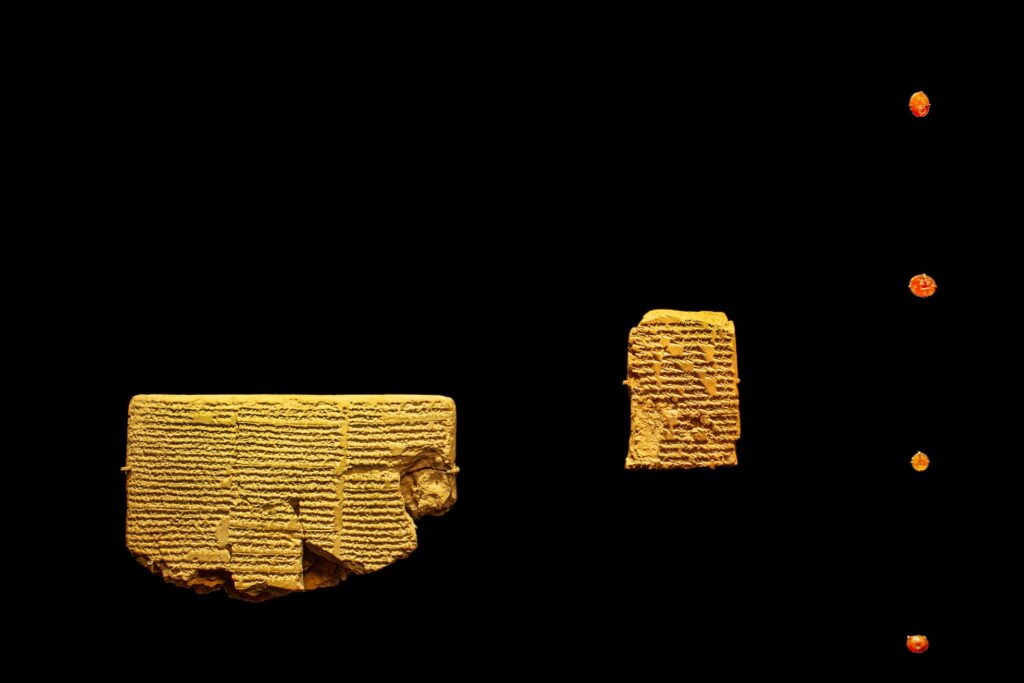
Object 5: Drawing the Constellations
Clay
Hellenistic period
(January 4, 214 BC)
Uruk
YPM BC 001864
MLC 1866
Object 6: Description of the Constellations and the Topography of Uruk
Clay
Seleucid period or early Parthian period (c. 300–100 BC)
Uruk
YPM BC 00188
MLC 1884
Object 7: Seal Bezel with Scorpion (Scorpio)
Carnelian
Hellenistic to Sasanian periods (c. 331–600 BC)
YPM BC 038127
NBC 12392
Object 8: Seal Bezel with Goat-fish (Capricorn)
Carnelian
Hellenistic Roman period (c. 100 BC – AD 100)
YPM BC 038128
NCBS 1070
Object 9: Seal Bezel with Scales (Libra)
Carnelian
Hellenistic Roman period (c. 100 BC – AD 100)
YPM BC 038129
NCBS 1071
Object 10: Seal Bezel with Crab (Cancer)
Carnelian
Hellenistic to Sasanian periods
(c. 331–600 BC)
YPM BC 038049
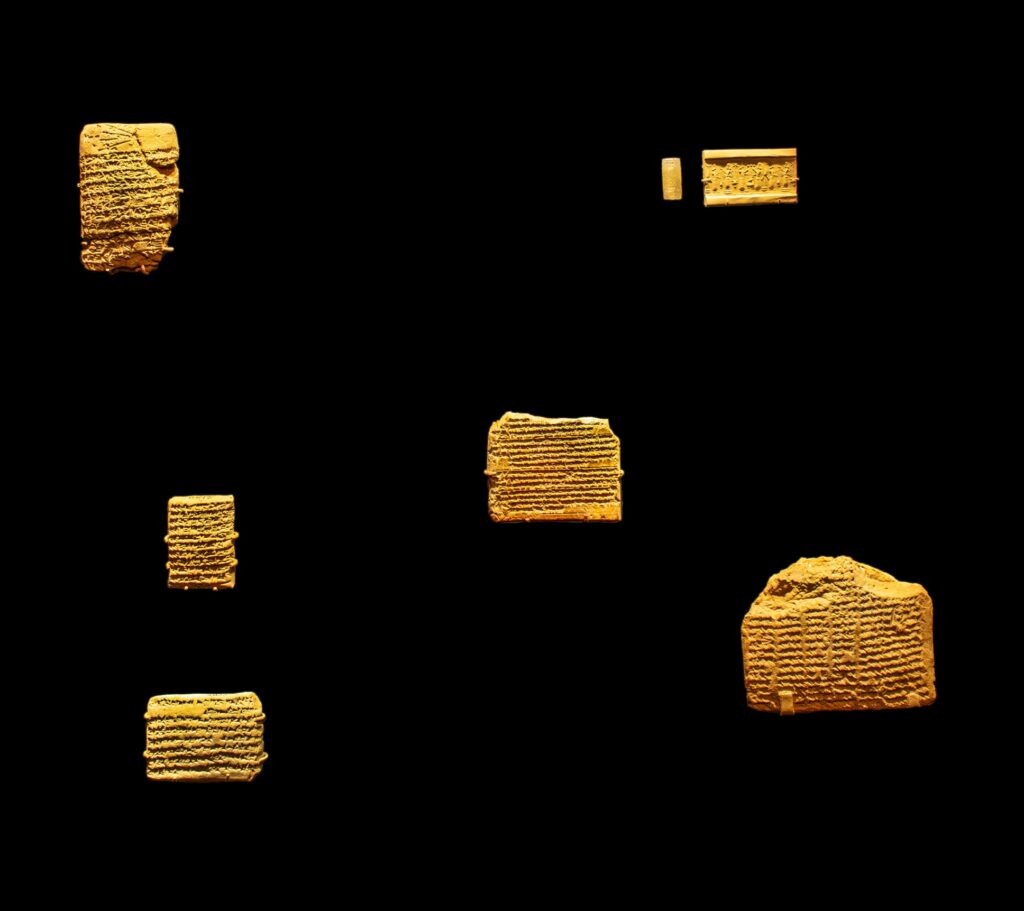
Object 11: Approximation of a Non-right Triangle’s Area
Clay
Old Babylonian period (1900–1600 BC)
YPM BC 022691
YBC 8633
Object 12: A Date List with Year Names
Clay
Old Babylonian period (1712 BC or later)
Babylonia
YPM BC 016768
YBC 2140
Object 13: List of Months Suitable for Healing Rituals
Clay
Late Babylonian period (second half of the first millennium BC)
YPM BC 023831
YBC 9833
Object 14: Cylinder Seal Displaying the Divine Sun, the Moon, and the Pleiades
Chalcedony
With rolled out impression on polymer
Neo-Assyrian period (934–612 BC)
YPM BC 038114
NBC 12330
Object 15: A Normal Star Almanac
Clay
Hellenistic period (179 BC)
Uruk
YPM BC 001883
MLC 1885
Object 16: Calculating the Velocity of the Moon
Clay
Hellenistic period (331–141 BC)
Uruk or Babylon
YPM BC 001878
MLC 1880
Panel: Predicting the Future
Ancient Mesopotamians believed that the gods sent signs to help them cope with the future.
Such divine signs could be found in the movements of celestial bodies, the grooves on the liver and other organs of a sacrificial lamb, the wrinkles of a man’s forehead, and in the behavior of wild and domestic animals.
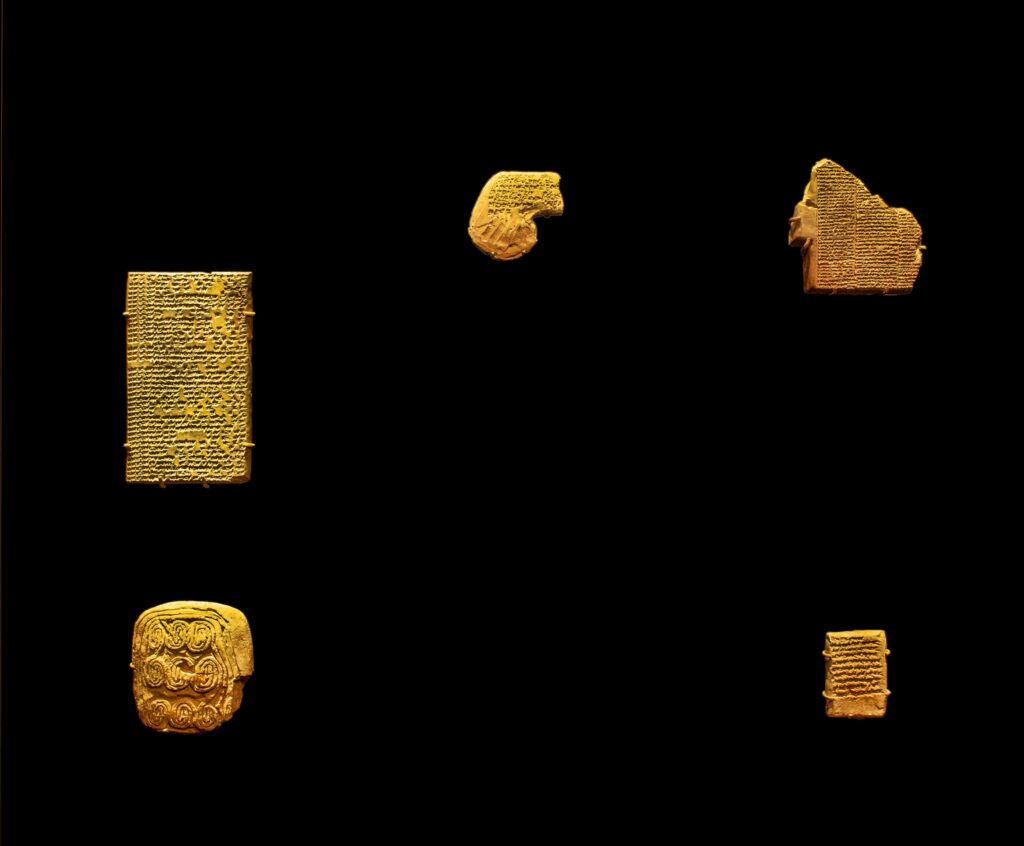
Object 1: Omens Derived from a Sheep’s Colon
Clay
Late Babylonian period, May 4, 213
Uruk
YPM BC 001872
MLC 1874
Object 2: Drawing of the Entrails of a Sacrificial Sheep
Clay
Probably Old Babylonian or Middle Babylonian period (second millennium BC)
YPM BC 016795
YBC 2167
Object 3: Liver Model Inscribed with an Omen Related to King Sin-iddinam of Larsa
Clay
Old Babylonian period (c. 1900–1600 BC)
Possibly from Larsa
YPM BC 023830
YBC 9832
Object 4: Horoscope of Aristocrates
Clay
Hellenistic period, 235 BC or later
Uruk
YPM BC 002136
MLC 2190
Object 5: List of Months Auspicious or Various Activities, with Commentary
Clay
Late Babylonian period (second half of the first millennium BC)
Possibly from Uruk
YPM BC 002575
MLC 2627
Panel: Healing
Along with their Egyptian colleagues, Mesopotamian physicians produced the earliest detailed medical texts ever written. Babylonian and Assyrian doctors identified many physical illnesses and psychological disorders. For treatments they used hundreds of plants and other substances, administered to patients to eat, or as potions, ointments, and suppositories, and through fumigation.
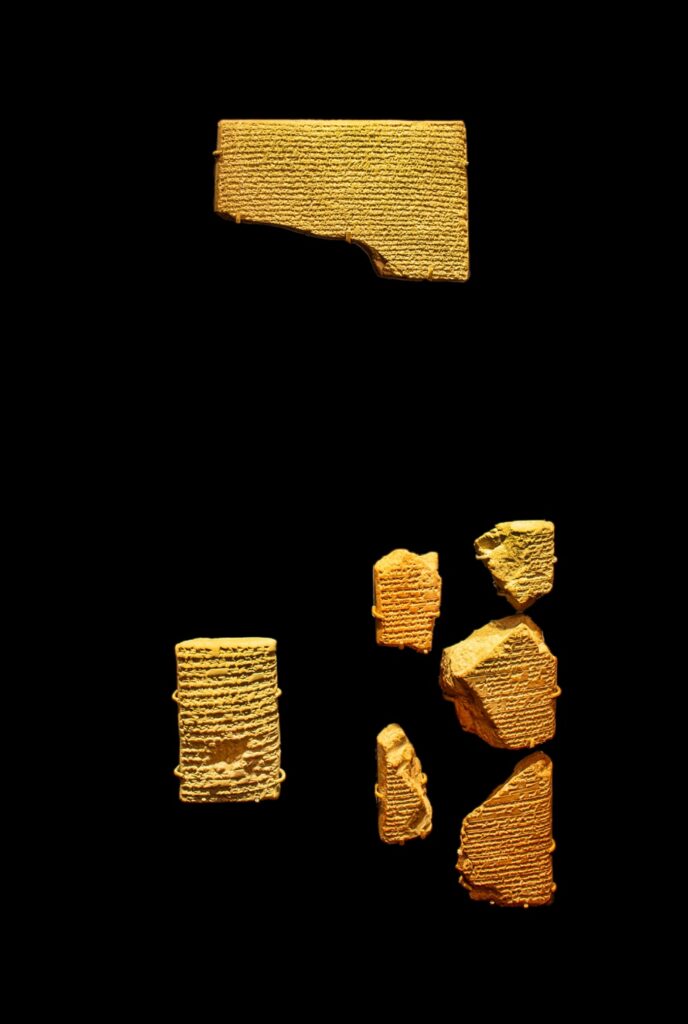
Top
Object: Commentary on a Text about Fumigations against Epilepsy
Clay
Persian period (539–331 BC)
Nippur or Uruk
YPM BC 001861
MLC 1863
Above
Object: Healing Scene
Neo-Assyrian period (934–612 BC)
Metropolitan Museum of Art, L.1994.88
Bottom left
Object: Incantations against the Tooth Worm and Scorpion Bites
Clay
Old Babylonian period (c. 1900–1600 BC)
YPM BC 018658
YBC 4593
Bottom right
Object: A Catalogue of Medical Treatises
Clay, four fragments from the Yale Babylonian Collection with a fragment from the Oriental Institute, University of Chicago, upper left Neo-Assyrian period (eighth or seventh century BC)
Assur
YPM BC 021187, YPM BC 021190,
YPM BC 021203, YPM BC 021210
YBC 7123, YBC 7126, YBC 7139, YBC 7146
On loan from the Oriental Institute Museum
OIM A 7821
SECTION 6: YALE BABYLONIAN COLLECTION
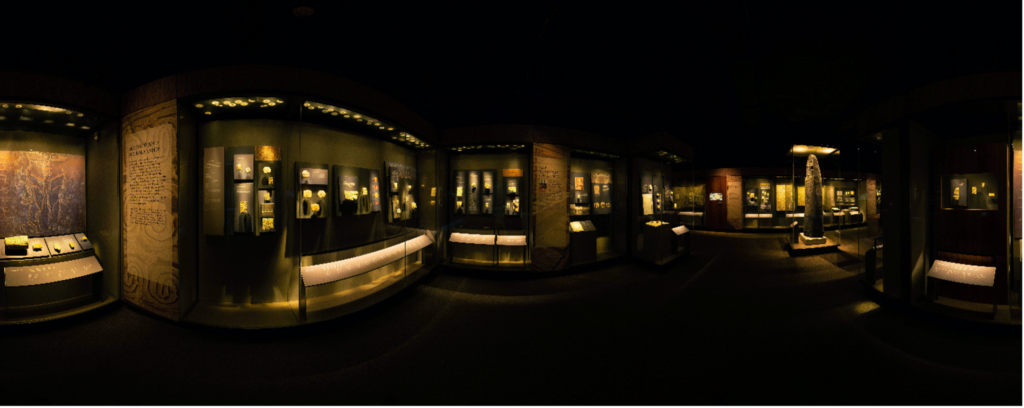
The Yale Babylonian Collection houses more than 40,000 cuneiform texts, seals, and other artifacts. The Collection’s holdings of tablets and other inscribed objects are among the most important in the world. Among the highlights—many on display here—are an early manuscript of the Epic of Gilgamesh, the world’s oldest cookbooks, and exquisitely carved seals.
From its founding in 1911, the Yale Babylonian Collection has been a center for research by students and faculty at Yale University, and for scholars from all over the world. It aims to preserve, publish, and make available for everyone the artifacts it houses.
Panel: The Babylonian Collection in Sterling Memorial Library
The Yale Babylonian Collection Found its permanent home as the very first occupant of Yale’s Sterling Memorial Library, completed in 1930, in a custom-designed suite. The floor of the room intended for the collection materials was rein forced to hold their significant weight. Windows were adorned with painted and stained glass insets with iconic Assyrian and Babylonian motifs. A frieze above the library’s entrance includes an Assyrian scribe and a cuneiform inscription from the royal library of Assurbanipal.
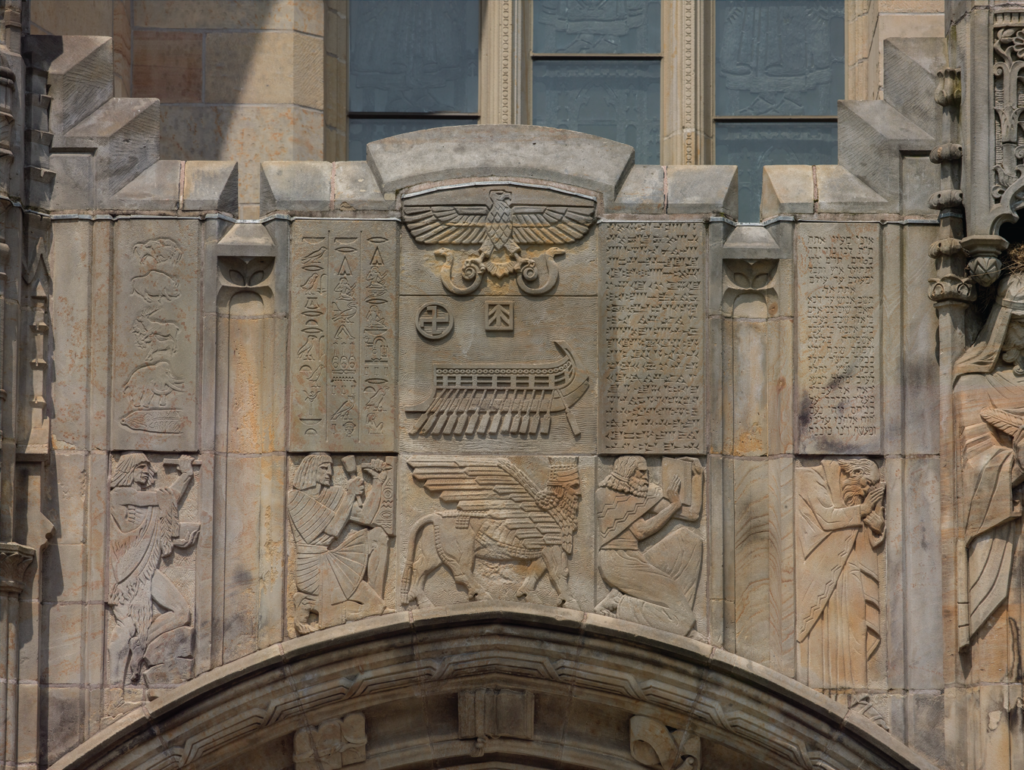
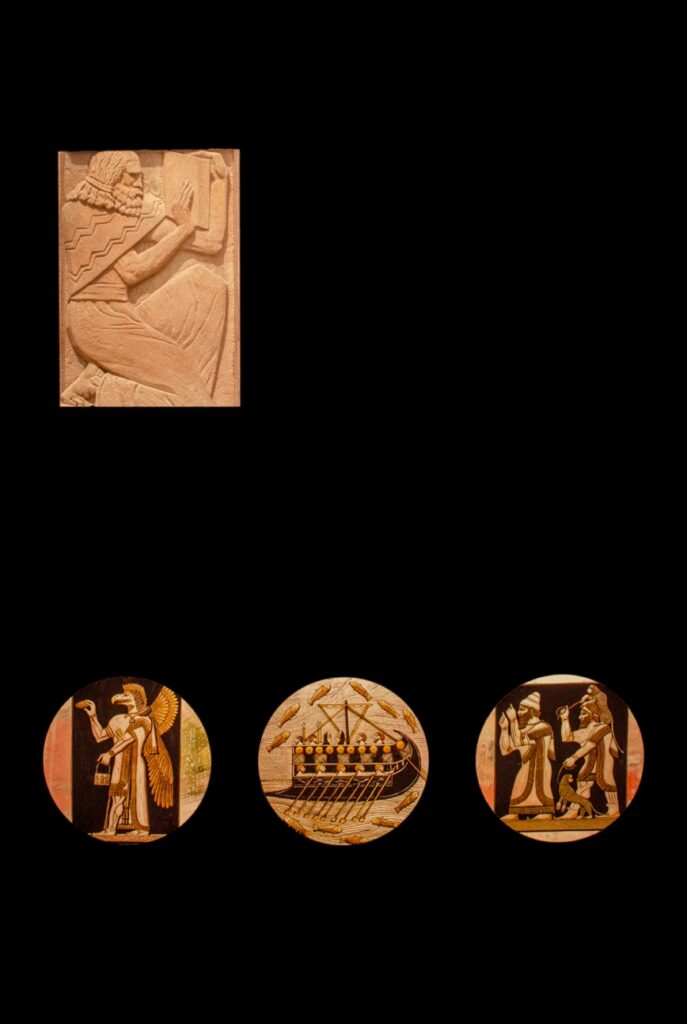
Albert T. Clay, founder of the Yale Babylonian Collection, received his doctorate in Assyriology and Semitic languages in 1894 from the University of Pennsylvania. Ambitious and energetic, he mounted expeditions to the Near East and published nineteen books. Appointed the William M. Laffan Professor of Assyriology and Babylonian Literature at Yale University in 1910, he began building a collection of inscriptions, seals, and casts with the aim of representing all periods and genres of Mesopotamian civilization.

Yale Babylonian Collection Archives
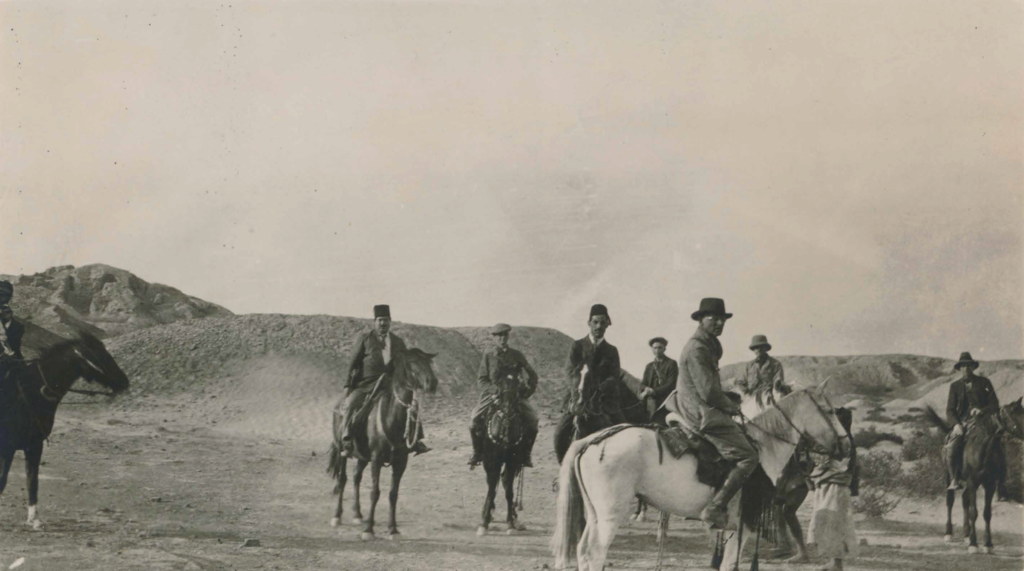
1920, Yale Babylonian Collection Archives
Cuneiform Commentaries Project and Website
Begun in 2013 in the work rooms of the Yale Babylonian Collection, Yale’s Cuneiform Commentaries Project, funded by the National Endowment for the Humanities, seeks to make the large corpus of Babylonian and Assyrian text commentaries available online to both the scholarly community and a wider audience. Cuneiform commentaries are the world’s oldest cohesive group of treatises that interpret literary and scholarly works. The project, co-directed by Eckart Frahm and Enrique Jiménez, collaborates with scholars and institutions worldwide.
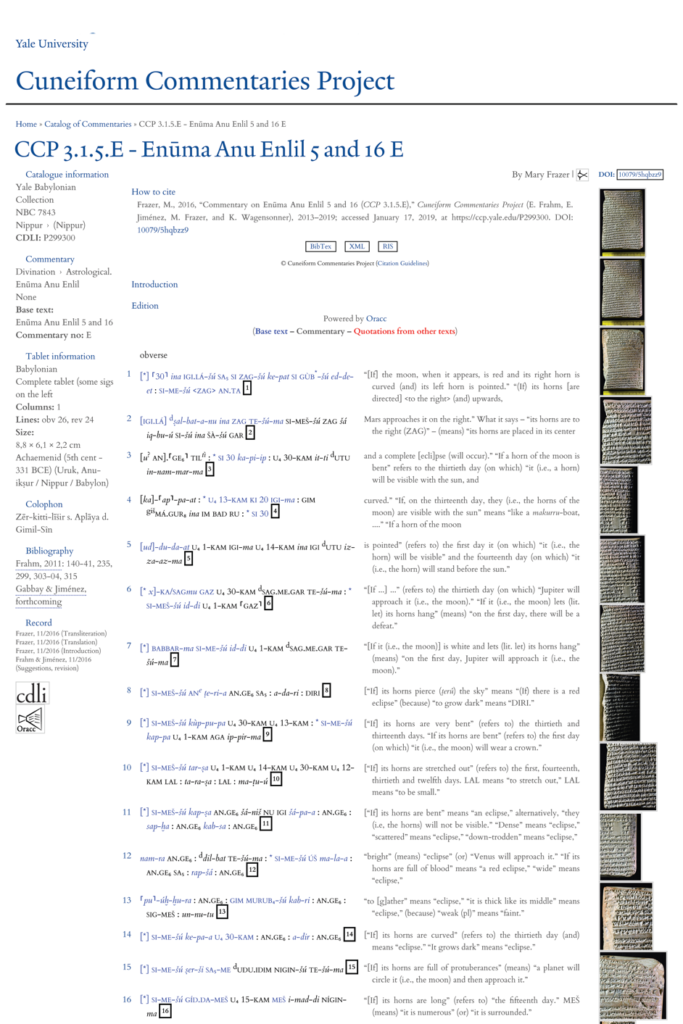
Digitizing Seals
Advanced photographic techniques and digital enhancement aid in the examination and interpretation of ancient artifacts. The flattened views of seals imaged here were captured using High Dynamic Range (HDR) photography. A stationary camera shoots sixty images around the circumference of a cylindrical seal placed in the center of a turntable. These images are then stitched together to create a flattened, two-dimensional digital roll-out. Merging different exposures enhances the carving, texture, and color of the stone.
Cylinder Seal Inscribed with a Prayer and Showing Three Deities (Jasper)

Kassite period (c. 1590–1155 BC)
YPM BC 006144
NBC 3171
Cylinder Seal Inscribed with a Prayer and Showing a Worshipper (Agate)

Kassite period (c. 1590–1155 BC)
YPM BC 006184
NBC 3211
Cylinder Seal Showing a Winged Bull and a Tree (Marble)

Kassite period (c. 1590–1155 BC)
YPM BC 037564
NCBS 667
Digitizing Tablets
Because a cuneiform artifact is a three-dimensional object, reading the script with its elevations and depressions presents challenges to the reader. The alignment of light and shadow on an artifact is critical, with some angles better than others for deciphering the signs and carved scenes of seals impressed in clay. Using Reflectance Transformation Imaging (RTI), the light source can be moved around to produce high-quality dynamic images that can be manipulated and shared with scholars worldwide.
The Digitizing the Yale Babylonian Collection project, funded beginning in 2019 by the Council on Library and Information Resources, intends to digitize Yale’s cuneiform holdings in their entirety and make them available online.
Along with flatbed scanning, which will be used to document all tablets, the project will use Reflectance Transformation Imaging and High Dynamic Range Imaging to capture the detail of particularly important or damaged artifacts. The project is directed by Agnete Wisti Lassen.
Current Research
The Yale Babylonian Collection is a vibrant research facility and a center for learning for students of the ancient Near East. Despite more than a century of dedicated work, only about half of its holdings have been published. Future work will focus on conservation, digitization, and publication. This section presents some of the current research in the Collection.
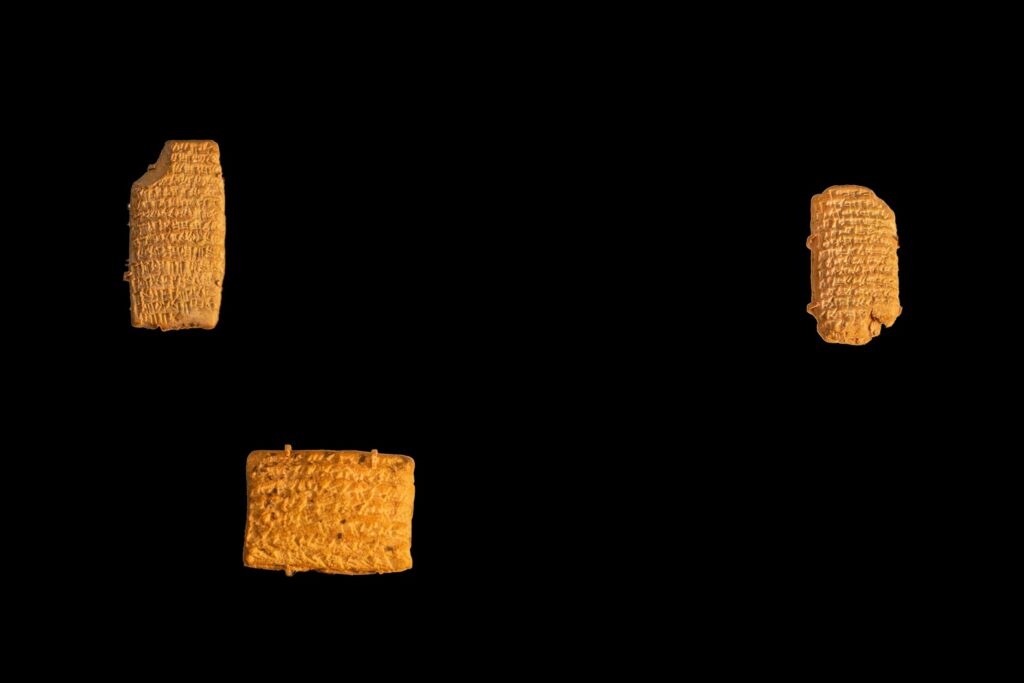
Left
A Book with Hand Drawings of Two-hundred Cuneiform Letters and Documents from the Yale Babylonian Collection
Neo-Babylonian Letters and Contracts from the Eanna Archive Eckart Frahm and Michael Jursa
Yale Oriental Series: Babylonian Texts, Volume 21
Yale University Press, 2011
Left, on book
Three Letters Regarding Business Matters of the Eanna Temple in Uruk
Clay
Neo-Babylonian period, sixth century
Uruk
YPM BC 034583, YPM BC 035705,
YPM BC 025047
NCBT 38, NCBT 1160, YBC 11253

